
OC230415
9 June 2023
Jay Thompson
[FYI request #22760 email]
Tēnā koe Jay
I refer to your two emails dated 11 May 2023 and 14 May 2023, requesting the following under the
Official Information Act 1982 (the Act):
•
“OC230143, Air New Zealand Kiwi Shareholder
•
OC230010 New Zealand - Solomon Islands Air Services Negotiations
•
OC230196 Meeting with the Civil Aviation Authority Chief Executive and Chair - 3 April
2023
•
OC230170 Air Navigation System Review
•
OC230193 Sustainable Aviation Aotearoa 2023
•
OC230272 Meeting with the Civil Aviation Authority Chief Executive and Chair - 3 April
2023”
On 14 May 2023, you requested these documents again with one extra briefing which is:
•
OC230128 - Te Manatū Waka Ministry of Transport protocol for Official Information Act
responses and proactive releases involving Ministers
Out of seven documents requested:
•
six are released with some information withheld
•
one is withheld in full.
Certain information, and one full document, is withheld under the following sections of the Act:
9(2)(a)
to protect the privacy of natural persons
9(2)(f)(iv)
to maintain the constitutional conventions for the time being which protect the
confidentiality of advice tendered by Ministers of the Crown and officials
9(2)(g)(i)
to maintain the effective conduct of public affairs through the free and frank
expression of opinions by or between or to Ministers of the Crown or
members of an organisation or officers and employees of any public service
agency or organisation in the course of their duty
9(2)(j)
to enable a Minister of the Crown or any public service agency or
organisation holding the information to carry on, without prejudice or
disadvantage, negotiations (including commercial and industrial negotiations)
With regard to the information that has been withheld under section 9 of the Act, I am satisfied that
the reasons for withholding the information at this time are not outweighed by public interest
considerations that would make it desirable to make the information available.
transport.govt.nz | hei-arataki.nz
HEAD OFFICE: PO Box 3175, Wellington 6140, New Zealand. PH: +64 4 439 9000
AUCKLAND OFFICE: NZ Government Auckland Policy Office, PO Box 106483, Auckland 1143, New Zealand. PH: +64 4 439 9000
You have the right to seek an investigation and review of this response by the Ombudsman, in
accordance with section 28(3) of the Act. The relevant details can be found on the Ombudsman’s
websi
te www.ombudsman.parliament.nz
The Ministry publishes our Official Information Act responses and the information contained in our
reply to you may be published on the Ministry website. Before publishing we wil remove any
personal or identifiable information.
Nāku noa, nā
Hilary Penman
Manager, Ministerial Services
transport.govt.nz | hei-arataki.nz
Page 2 of 3
Annex 1 - Document Schedule
Doc #
Reference
Document
Decision on release
1
OC230128 Te Manatū Waka Ministry of Transport
Released with some information withheld
Protocol for Official Information Act
under Section 9(2)(a).
Responses and Proactive Releases Involving
Ministers
2 2 OC230143 Air New Zealand Kiwi Shareholder
Released with some information withheld
under Section 9(2)(a).
3 3 OC230010 New Zealand - Solomon Islands Air Services Withheld in full under Section 9(2)(j)
Negotiations
4 4 OC230196 Meeting with the Civil Aviation Authority
Released with some information withheld
Chief Executive and Chair – 15 March 2023
under Sections 9(2)(a), 9(2)(f)(iv) and
9(2)(g)(i).
5 5 OC230170 Air Navigation System Review
Released with some information withheld
under Section 9(2)(a).
The briefing refers to the Air Navigation
System Review Phase 2 Report which has
been published on the Ministry’s website
https://www.transport.govt.nz/assets/Uploads
/Air-Navigation-System-Review-phase-two-
report-May-2023.pdf
6 OC230193 Sustainable Aviation Aotearoa 2023
Released with some information withheld
under Section 9(2)(a).
7 OC230272 Meeting with the Civil Aviation Authority
Released with some information withheld
Chief Executive and Chair - 3 April 2023”
under Sections 9(2)(a), 9(2)(f)(iv) and
9(2)(g)(i)..
transport.govt.nz | hei-arataki.nz
Page 3 of 3

UNCLASSIFIED
Document 1
1 March 2023
OC230128
Hon Michael Wood
Action required by:
Minister of Transport
Wednesday, 22 March 2023
TE MANATŪ WAKA MINISTRY OF TRANSPORT PROTOCOL FOR
OFFICIAL INFORMATION ACT RESPONSES AND PROACTIVE
RELEASES INVOLVING MINISTERS
Purpose
Seek your approval to sign the attached protocol document.
ACT 1982
Key points
•
In his report ‘OIA Compliance and Practice in the Ministry of Transport’, published
October 2021, the Ombudsman recommended Te Manatū Waka Ministry of Transport
(the Ministry) adopt a protocol to govern interactions with Ministers’ Offices.
•
The Ministry has prepared the attached protocol [Ministry Protocol for OIA Responses
and Proactive Releases Involving Ministers] to provide guidance on both Of icial
Information Act responses and proactive releases.
INFORMATION
•
It is based on the Ombudman’s draft protocol and draws heavily on the protocol you
have already signed with Waka Kotahi New Zealand Transport Agency (signed
RELEASED UNDER
24 September 2021).
•
Your Of ice was consulted on an earlier version of this protocol and that feedback
was incorporated, particularly as it relates to the proactive release of information.
•
The protocol provides both the Ministry and your Of ice with a framework to guide any
discussions relating to Official Information Act responses and provides guidance
around timings related to proactive release.
•
Following your signature, the Ministry wil provide a copy to the Associate Minister of
THE OFFICIAL
Transport with the recommendation that she also signs it.
•
In line with the recommendation of the Ombudsman, the Ministry wil publish the
signed protocol on the Ministry’s website as part of its commitment to proactive
release.
UNCLASSIFIED
Page
1 of
2
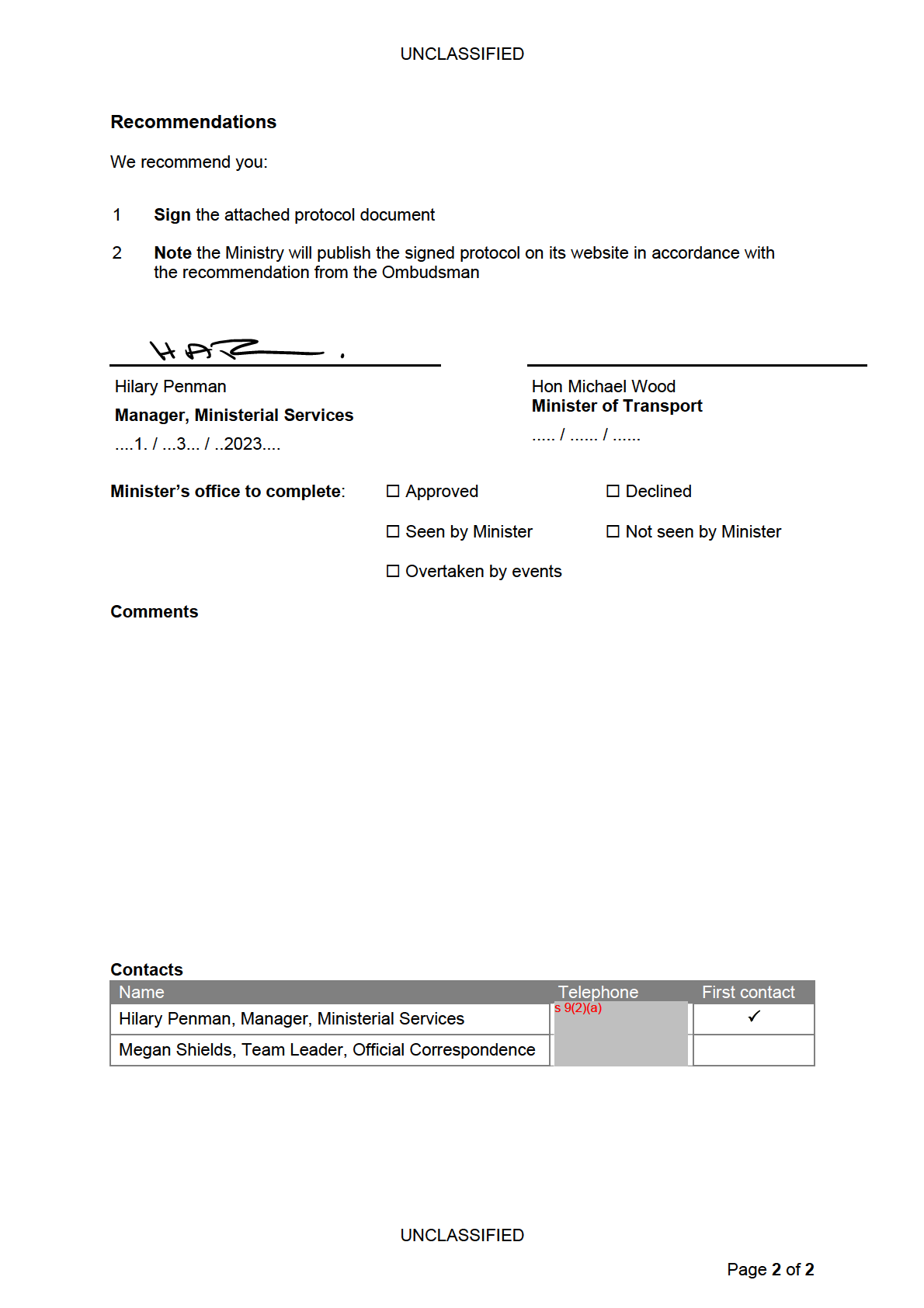
1982
ACT
UNDER
INFORMATION
RELEASED
OFFICIAL
THE
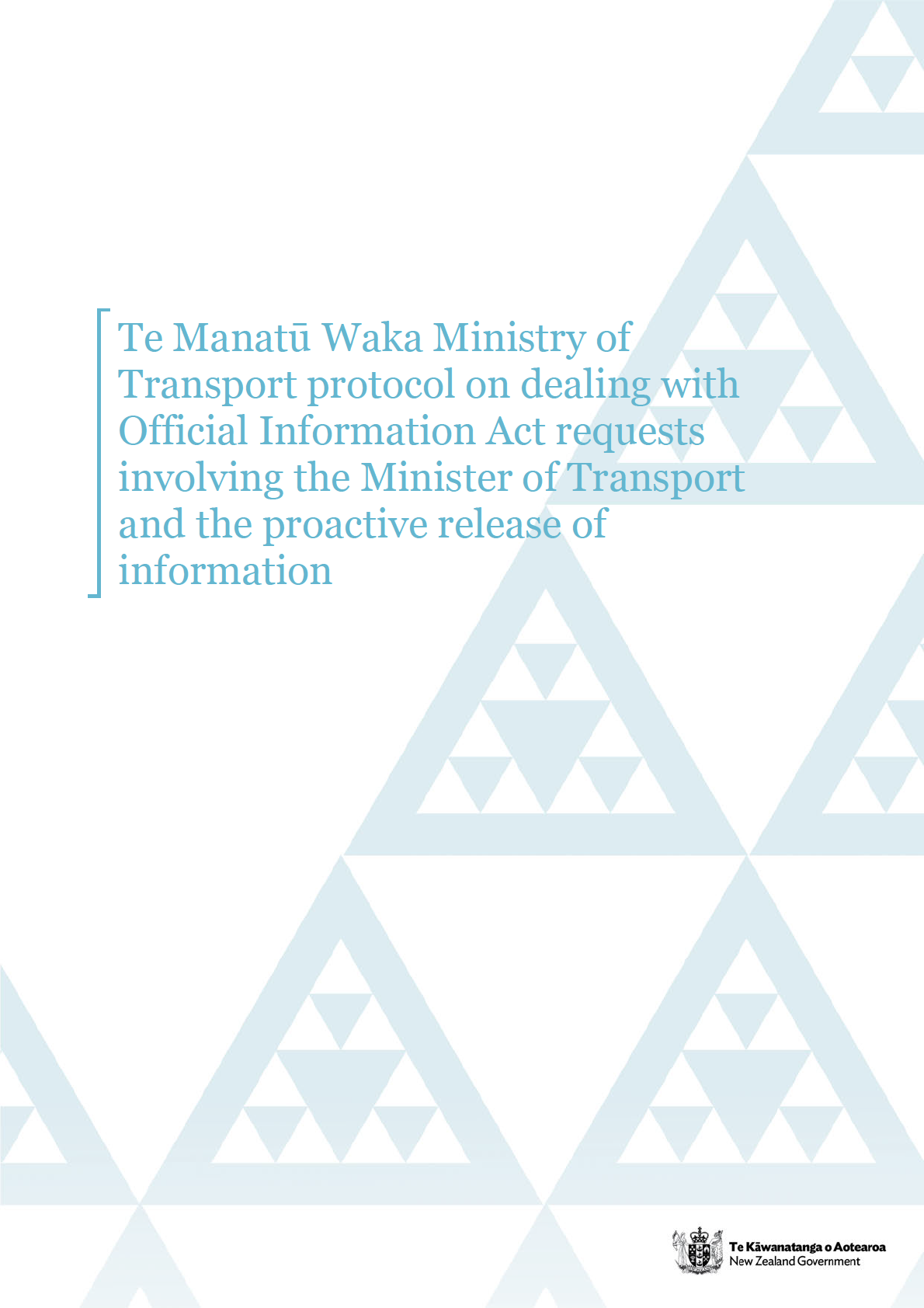
1982
ACT
UNDER
INFORMATION
RELEASED
OFFICIAL
THE
Contents
Background and purpose .................................................................................. 3
Part One: OIA requests ..................................................................................... 3
1
Context and principles ............................................................................... 3
2 Notification of requests .............................................................................. 4
3 Transfer 4
4 Consultation ............................................................................................... 5
5
Notification of the decision ........................................................................ 5
6 Sending a copy of a sent response for information .................................... 6
7
Record keeping .......................................................................................... 6
8 Assistance .................................................................................................. 6
Part Two: Proactive release of information ....................................................... 6
1982
9 Background ................................................................................................ 6
10 Preparing documents for release ............................................................... 7
11 Process 7
ACT
12 Timing 7
13 Disputes 8
UNDER
INFORMATION
RELEASED
OFFICIAL
THE
Background and purpose
The parties to this protocol are Te Manatū Waka Ministry of Transport (the Ministry) and the
Minister of Transport (the Minister).
This protocol is effective from the date signed. It expires when the present Minister of
Transport no longer holds that position.
The purpose of this protocol is to set out how the Ministry and the Minister (as well as the
Minister’s office on the Minister’s behalf) wil engage on Official Information Act (OIA)
requests involving the Minister made to the Ministry, and the proactive release of
information.
The Ministry intends to publish the operative version of this protocol on its website.
1982
Part One: OIA requests
OIA requests involving the Minister are ones where there is the potential for the Minister to
be affected by the release of the requested information because:
ACT
• it relates to their functions or activities as a Minister;
• the Minister may be required to prepare for the possibility of public or political
commentary.
UNDER
1
Context and principles
1.1
The Ministry and the Minister acknowledge the principle of availability that
underpins the Of icial Information Act (the Act), which means that official
information must be made available on request unless there is good reason, in
terms of the Act, for withholding it.1
INFORMATION
1.2
The Ministry, the Minister, and the Minister’s office, wil apply this protocol in a way
RELEASED
that does not interfere with statutory obligations to make and communicate
decisions on OIA requests as soon as reasonably practicable and within 20
working days2 (subject to extension only where necessary),3 and to release official
information without undue delay.4
1.3
The Minister recognises that the Ministry is responsible for making decisions on
OIA requests it receives, unl
OFFICIAL ess those requests are required to be transferred to
the Minister (or other appropriate organisations) in accordance with section 14 of
the Act.
1.4
The Ministry recognises that the Minister may need to make, be involved in, or
THE
know about decisions on OIA requests involving the Minister.
_______________
1
See s 5 OIA.
2
See s 15(1) OIA.
3
See s 15A OIA.
4
See s 28(5) OIA.
1.5
The Ministry wil work with the office of the Minister to identify OIA requests
involving the Minister and decide the appropriate mechanism for dealing with them,
which may include:
•
transfer;
•
consultation;
•
notification of the decision;
1.6
The Ministry and the Minister acknowledge that this is a decision to be made on the
facts of each request, and in accordance with the law, and not pursuant to any
general policy or directive.
2 Notification of requests
2.1
The Ministry wil notify the office of the Minister of receipt of any OIA requests
1982
involving the Minister including, but not limited to where the requested information:
•
relates to the Minister's functions or activities;
•
could impact on the Minister’s functions or activities; ACT
•
was generated by or on behalf of the Minister;
•
is sensitive or controversial;
•
is likely to be published in the news media5 or debated in the House.
UNDER
2.2
Notification of receipt of OIA requests wil be carried out through a weekly list
supplied to the Minister’s office from the Ministry’s Official Correspondence Unit.
3 Transfer
3.1
The Ministry wil transfer all or part of an OIA request to the Minister when that is
INFORMATION
required under section 14 of the Act—that is when the requested information is:
RELEASED
•
not held by the Ministry but is believed by the person dealing with the request
to be held by the Minister;
•
believed by the person dealing with the request to be more closely
connected with the functions of the Minister.
3.2
The need for transfer wil be determined on the facts of the particular request, with
regard to the specific inform
OFFICIAL ation at issue and the functions of the Minister, and in
consultation with the office of the Minister.
3.3
The Minister will likewise transfer all or part of an OIA request to the Ministry when
that is required under section 14 of the Act.
THE
_______________
5
Following the definition in s 68(5) of the Evidence Act 2006,
'news media' is media for the dissemination to the public or a section
of the public of news and observations on news. Following the judgment of the High Court in
Slater v Blomfield [2014] NZHC
2221, this can include a blogger who regularly disseminates news (ie, new information about recent events or events of interest to
the public), or observations on news, to a significant body of the public.
4 Consultation
4.1
The Ministry wil work with the office of the Minister to identify requests requiring
consultation.
4.2
Consultation may be required with the Minister where, for example:
•
the Minister supplied the information;
•
it is about, or relates to, the functions or activities of the Minister;
•
release could affect the Minister’s functions or activities or legitimate
interests.
4.3
The Ministry wil provide the Minister with all information necessary for informed
consultation, including the request, the information at issue, and the decision the
Ministry proposes to take. The Ministry wil allow a minimum of five working days
for consultation to take place, unless the circumstances of the particular request
demand a shorter period of time.
1982
4.4
The office of the Minister wil respond to all consultations as expeditiously as
possible. The office of the Minister wil let the Ministry know if more time is required
so that the Ministry can consider whether it is necessary to extend the maximum 20
ACT
working days for making a decision on the request.
4.5
The office of the Minister wil provide appropriate input in response to the Ministry
requests for consultation. Appropriate input means comments and suggestions
regarding the:
UNDER
•
proper application of the withholding grounds and the public interest test;
•
knowledge or release of additional information, including additional
explanatory material to place the information that is being released in its
proper context;
•
proactive release of the same information to others, provided there is no
undue delay in providing that information to the requester.
INFORMATION
4.6
Inappropriate input includes matters such as raising irrelevant considerations (like
RELEASED
political embarrassment), or asking or instructing the Ministry to act in a way that
would be contrary to the requirements of the Act, including withholding or delaying
the release of official information without any proper statutory basis.
4.7
The Minister acknowledges that final responsibility for deciding on Ministry
requests rests with the Ministry.
4.8
The Ministry wil consider the
OFFICIAL input of the Minister’s office on an OIA request in
good faith and with an open mind, before deciding whether that input provides a
reasonable basis for changing its proposed decision on the request. The Ministry
may proceed to make a decision on an OIA request if the Minister’s of ice does not
THE
respond to the consultation or advise that further time is required.
5 Notification of the decision
5.1
The Ministry will work with the of ice of the Minister to identify decisions on OIA
requests requiring notification. Notification may be required where the requested
information:
•
is sensitive or controversial in nature;
•
relates to a matter of significance within his portfolio responsibilities;
•
relates to where the Minister has been previously briefed on a matter, to
ensure they are kept up-to-date;
•
is likely to be published in the news media or debated in the House.
5.2
The Ministry wil provide the Minister with all information necessary for notification,
including the request, the information at issue, and the decision the Ministry is
taking.
5.3
Notification to the Minister wil be provided on the working day before the decision
is communicated to the requester, unless the circumstances of the particular
request demand it to be carried out on the same day. It wil be for the Minister’s
information only and no feedback is sought.
1982
6 Sending a copy of a sent response for information
6.1
The Ministry wil work with the office of the Minister to identify responses where it is
appropriate that a copy of a sent response be shared with the Minister for
ACT his
information only.
6.2
The Ministry wil provide the Minister with all the information provided to the
requester. A copy of the response wil be sent to the office of the Minister only after
UNDER
the response has been sent to the requester.
7 Record keeping
7.1
The Ministry and the Minister wil keep full and accurate records of interactions in
relation to OIA requests, in accordance with normal prudent business practice, as
required by section 17(1) of the Public Records Act 2005.
INFORMATION
RELEASED
8 Assistance
8.1
The Office of the Ombudsman offers an advisory service on the operation of the
Act. They can be contacted by email [email address] or freephone
0800 802 602. The Of ice should be contacted as early as possible to ensure it can
answer any queries without delaying the response to an OIA request.
OFFICIAL
Part Two: Proactive release of information
THE
9 Background
9.1
Cabinet Office Circular CO18(4) mandates that Cabinet papers and associated
minutes be proactively released within 30 business days of decisions being made
by Cabinet unless it is indicated it is not for publishing, or only partial material is to
be published.
9.2
In addition to this, Cabinet agreed that government agencies should increase the
breadth and depth of information proactively released by agencies (ref CAB-22-
MIN-0168.01).
9.3
Material covered by this protocol includes Cabinet papers and associated minutes,
briefings including the Weekly Report, and titles of briefings.
10 Preparing documents for release
10.1
Documents wil be prepared for release by the Ministry, withholding information
consistent with the grounds in the Of icial Information Act 1982.
10.2
The Office and the Ministry both acknowledge that Section 48 of the Act, which
protects Ministers and agencies from civil or criminal liability where information is
released under the Act, does not apply to information that is proactively released.
1982
11 Process
11.1
All Cabinet papers and minutes marked as suitable for proactive release wil be
ACT
prepared for release by the Ministry. The Ministry wil then seek the Minister’s
approval to publish the documents via a formal briefing. Once the Minister’s
approval is given, documents wil be published on the Ministry’s website.
11.2
Documents, including the Weekly Report, and titles of briefings suitable for
UNDER
proactive release wil be prepared for release by the Ministry. Depending on the
document, it may or may not require the Minister’s approval. The Ministry wil liaise
with the Office to determine which documents can be approved for release by the
Of ice, and which need the Minister’s writ en approval.
12 Timing
INFORMATION
12.1
The Office and the Ministry both acknowledge that there are time sensitivities
RELEASED
around when information needs to be published.
Cabinet Papers
12.2
As stated above, unless otherwise noted, Cabinet material should be released
within 30 business days of decisions being made.
12.3
To ensure Cabinet material
OFFICIAL is released within the 30 day timeframe mandated by
Cabinet, if it is part of a larger proactive release including additional background
documents the Ministry wil provide the Cabinet material separately to enable the
Office to prioritise it.
THE
12.4
The Ministry wil provide the Of ice a minimum of five days for review of material
proposed for release.
Briefing Papers and Weekly Reports
12.5
In many cases there is a time imperative for briefings to be released.
12.6
Documents are requested under the OIA and can be refused under Section 18(d),
if they wil soon be publicly available. The Of ice of the Ombudsman states that

where this ground is used, information must be made publicly available within six to
eight weeks of the refusal.
12.7
The Ministry wil provide the Of ice a minimum of five days for review of material
proposed for release.
12.8
In cases where a substantial amount of information is being released, the Ministry
wil advise the Of ice ahead of time.
12.9
The Office accepts they wil respond within the stated timeframes to ensure
statutory deadlines are met.
13 Disputes
13.1
Where disputes arise between the parties regarding the proper application of the
Act, the proactive release of information, or this protocol, these should be referred
to the Ministry’s Deputy Chief Executive, Corporate Services, and the Ministerial
1982
Advisor in the Office of the Minister of Transport.
ACT
UNDER
Signed by:
INFORMATION
Date:
Date: 5 April
RELEASED 2023
Hon Michael Wood
Robyn Smith
Minister of Transport
Pou Turuki, Te Kāhui Tangata
Deputy Chief Executive, Corporate Services
OFFICIAL On behalf of:
Tumu Whakarae, Te Manatū Waka
Chief Executive, Ministry of Transport
THE

1982
ACT
UNDER
INFORMATION
RELEASED
OFFICIAL
THE
transport.govt.nz
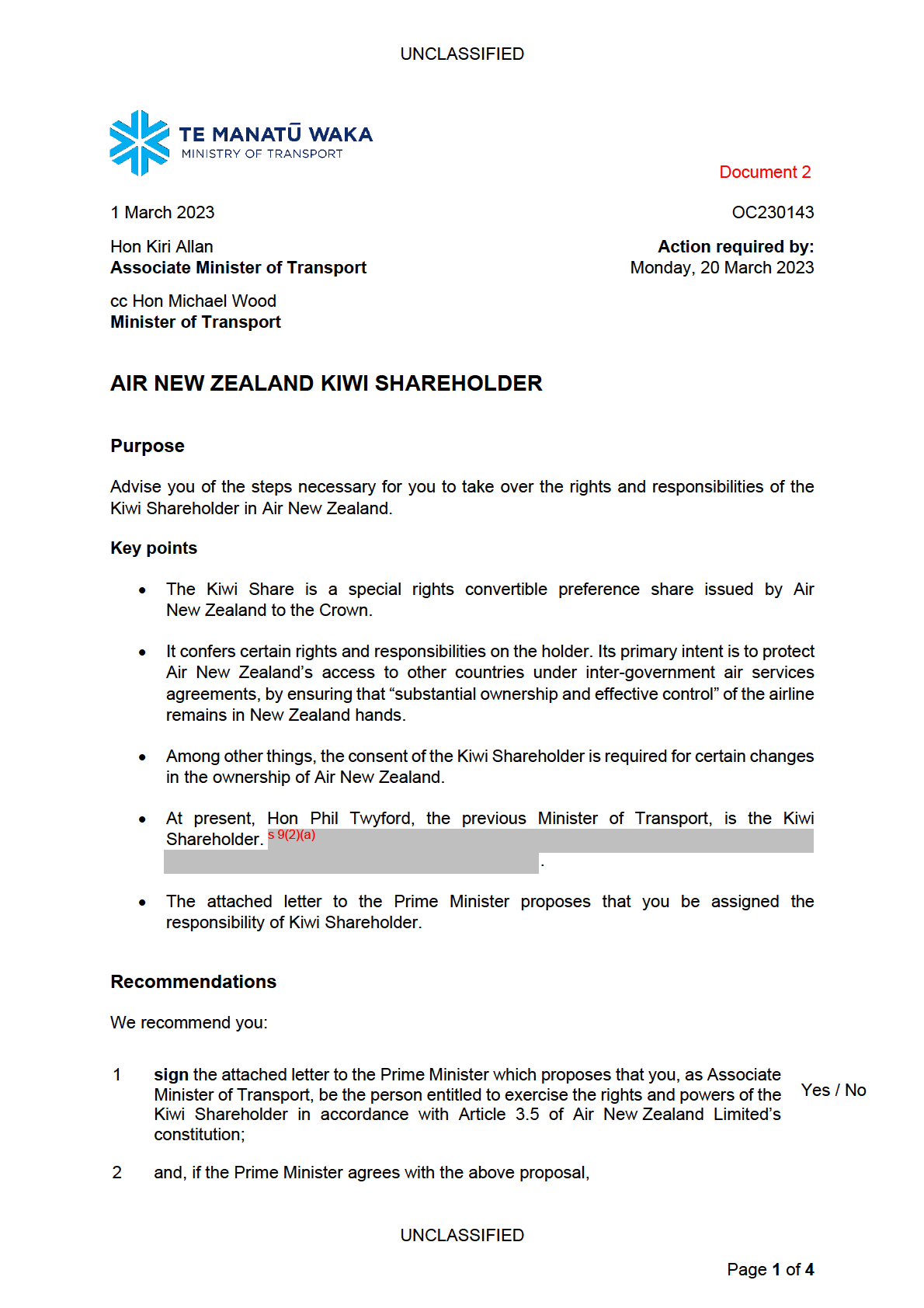
1982
ACT
UNDER
INFORMATION
RELEASED
OFFICIAL
THE

1982
ACT
UNDER
INFORMATION
RELEASED
OFFICIAL
THE
UNCLASSIFIED
AIR NEW ZEALAND KIWI SHAREHOLDER
The Kiwi Shareholder is a mechanism to protect Air New Zealand’s rights as a
New Zealand airline
1
The Kiwi Share is a single $1 special rights convertible preference share issued by Air
New Zealand to the Crown. It confers certain rights and responsibilities on the holder.
2
The primary intent is to protect Air New Zealand’s access to other countries by ensuring
that “substantial ownership and effective control” of the airline remains in New Zealand
hands. This is a requirement of many of the air services agreements under which Air
New Zealand operates.
3
Air New Zealand’s constitution sets out the rights and powers of the Kiwi Share and the
Kiwi Shareholder.
1982
4
Among other things, the written consent of the Kiwi Shareholder is required for any
amendment, removal, or alteration in effect of specified provisions in the constitution.
These include the name of the company, its place of incorporation, its principal place
ACT
of business, the location of its head office and the nationality of its directors. In addition,
the rights attaching to the Kiwi Share itself are entrenched and cannot be changed
without the consent of the Kiwi Shareholder.
5
The consent of the Kiwi Shareholder is also required in relation to specified
UNDER
circumstances or events, including:
a) for an owner or operator of an airline business to hold or have an interest in an
equity security in the company; and
b) for a non-New Zealand national to hold or have an interest in shares that confer
10 per cent or more of the total voting rights in the company.
INFORMATION
6
The Kiwi Shareholder’s role is separate from the ownership rights exercised by the
RELEASED
Minister of Finance. The Minister of Finance holds 51 percent of the ordinary shares in
Air New Zealand on behalf of the Crown.
We propose that you become the Kiwi Shareholder
7
Air New Zealand’s constitution provides that any Minister may give writ en notice to the
Company Secretary of the person
OFFICIAL who can exercise the rights and powers of the Kiwi
Shareholder.
8
Long-standing practice has been for the Minister of Transport to be assigned the rights
THE
and responsibilities of the Kiwi Shareholder in accordance with Air New Zealand’s
constitution, provided they held no personal shareholding in the airline.
9
At present, MP Phil Twyford, the previous Minister of Transport, is the named person.
s 9(2)(a)
UNCLASSIFIED
Page
3 of
4
UNCLASSIFIED
10
We propose that you take on the role of Kiwi Shareholder. It fits closely with your
delegated function as the airline’s licensing authority under the Civil Aviation Act 1990.
It relates to the grounds under which other countries could deny access to New Zealand
airlines under air services agreements negotiated with those countries.
Next Steps
11
If you agree to the proposal, please sign the attached letter to the Prime Minister
proposing that you be assigned the responsibility of Kiwi Shareholder.
12
If the Prime Minister agrees to the proposal, we have prepared a letter for your
signature. The letter advises Air New Zealand, in accordance with Article 3.5(a) of the
company’s constitution, that you are the person entitled to exercise the rights and
powers of the Kiwi Shareholder.
13
We will provide you with a briefing if Air New Zealand proposes an amendment to its
1982
constitution requiring your consent, or a specified event occurs that triggers the
requirement for the consent of the Kiwi Shareholder. This may necessitate seeking
external legal advice. Applications for consent have, in the past, been very infrequent.
ACT
Consultation
14
We consulted The Treasury, which supports our recommendation that you become the
Kiwi Shareholder.
UNDER
INFORMATION
RELEASED
OFFICIAL
THE
UNCLASSIFIED
Page
4 of
4
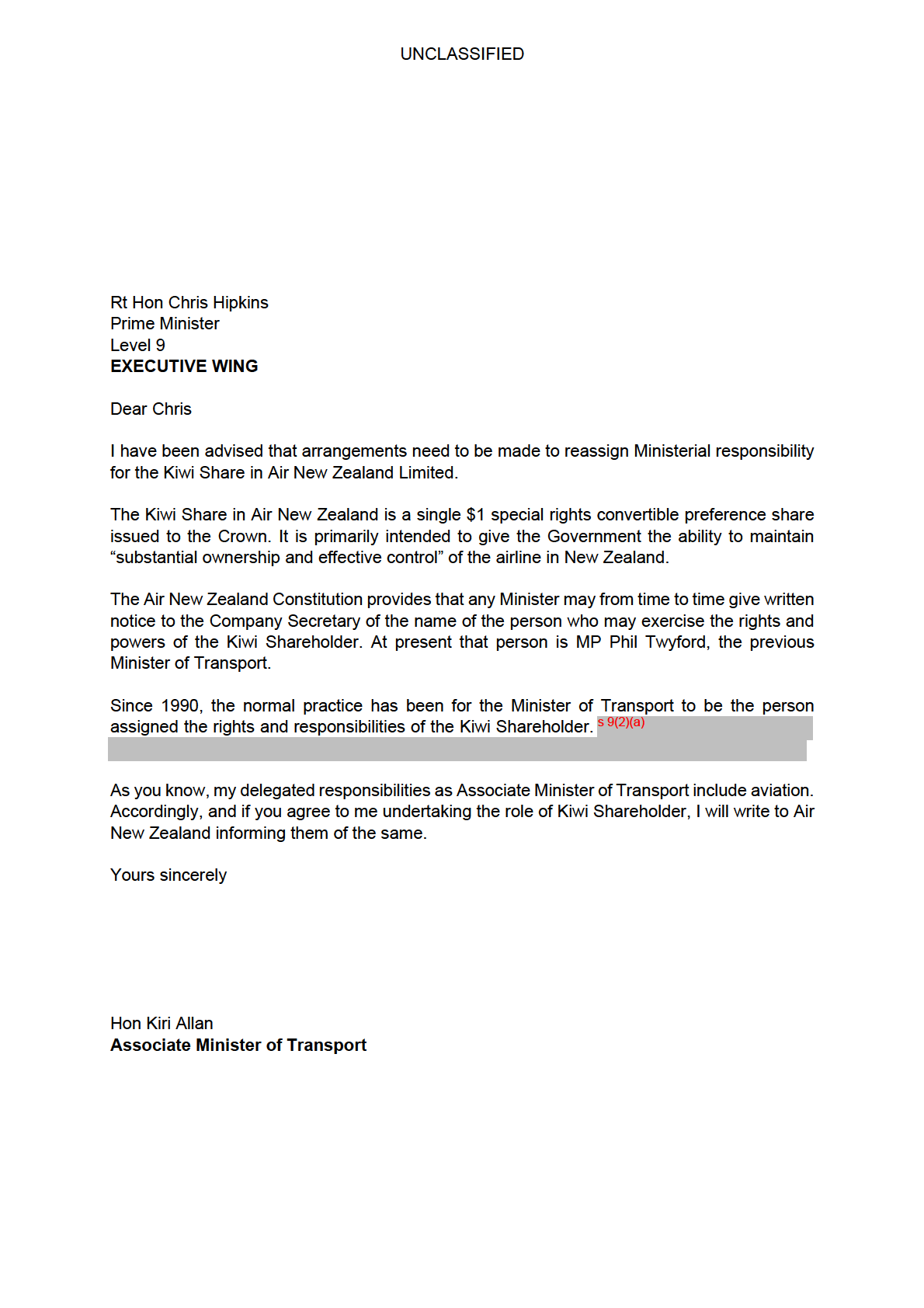
1982
ACT
UNDER
INFORMATION
RELEASED
OFFICIAL
THE
UNCLASSIFIED
Hon Kiri Allan
Associate Minister of Transport
Executive Of ices
Parliament Buildings
WELLINGTON
1982
Dear Kiri
By letter of ….. March 2023, you sought my agreement to your assuming the function of Kiwi
Shareholder in Air New Zealand Limited.
ACT
I agree to you assuming the function of Kiwi Shareholder in Air New Zealand Limited and to
you advising the airline’s Company Secretary accordingly.
UNDER
Yours sincerely
INFORMATION
Rt Hon Chris Hipkins RELEASED
Prime Minister
OFFICIAL
THE
UNCLASSIFIED
Ms Jennifer Page
Company Secretary
Air New Zealand Limited
Private Bag 92007
AUCKLAND
Dear Ms Page
1982
With reference to Article 3.5(a) of the Constitution of Air New Zealand Limited, notice is hereby
given that I, Kiri Allan, Associate Minister of Transport, am henceforth the person entitled to
exercise the rights and powers of the Kiwi Shareholder in Air New Zealand Limited on behalf
of the Crown.
ACT
Yours sincerely
UNDER
Hon Kiri Allan
Associate Minister of Transport
INFORMATION
RELEASED
OFFICIAL
THE

1982
ACT
UNDER
INFORMATION
RELEASED
OFFICIAL
THE
MEETING WITH THE CIVIL AVIATION AUTHORITY CHIEF
EXECUTIVE – 15 MARCH 2023
Key points
• You are meeting with Janice Fredric (Chair) and Keith Manch (Chief Executive) of the Civil
Aviation Authority (the Authority) on 10 March 2023.
• The advice for this meeting has been drafted in consultation with the Authority.
• This is the first of your regular meetings with the Authority’s Chair and Chief Executive
since you took up your delegation. s 9(2)(g)(i)
1982
• The Authority requests the opportunity to further discuss with you:
• its current financial position, and that of the sector;
ACT
• the funding options for CAA and AvSec that it seeks to consult with the public on;
s 9(2)(f)(iv)
•
UNDER
•
• Suggested talking points are provided for your consideration in
Annex 1.
The Chair may also wish to discuss reappointments to the Board
INFORMATION
• The terms of the Chair and Board member, Charles Spillane, expired on 2 December 2022.
Both have confirmed their interest in being reappointed and have accepted a request to
RELEASED
stay on the Board until their reappointment is confirmed or a successor has been found.
• We suggest that you do not confirm reappointment decisions at this meeting, but note that
you have recently taken up the delegation and will consider Board reappointments shortly.
OFFICIAL
THE
IN CONFIDENCE
Page
2 of
6
Item one: Funding review
Funding reviews usually operate on a three-year funding cycle with ‘mid-point’ reviews
alternating with more fundamental reviews every six years
1. In response to COVID-19, Cabinet issued a moratorium on border transport agency
funding reviews (CVD-20-MIN-0010 refers), which was lifted in 2021 (DEV-21-MIN-
0192 refers).
2. Prior to this, the most recent funding review had been completed by CAA (the
Authority’s regulatory function) in 2016, and Aviation Security Service (AvSec its
security function) in 2019. The Authority had completed a review and was in the
process of recommending changes to fees, charges, and levies in early 2020 when the
moratorium was introduced.
1982
3. Since the last funding review, significant additional activity has been required. In part
this is in response to the impacts of COVID-19, but also in relation to changes to the
operational / regulatory environment such as emerging technologies, and changing
risks in the aviation systems that were not contemplated in 2016 or 2020. Further,
ACT
inflation has compounded the issues generated by changes in the aviation system.
4. Since 2020, the Authority has been dependent on Crown funding – through the Since
2020, the Authority has been dependent on Crown funding - through the
Protection of
Transport Sector Agency Core Functions appropriation (known as the ‘liquidity facility’)
UNDER
– to bridge the gap between forecast levy revenue and actual revenue.
5. The liquidity facility has enabled the delivery of core services that were no-longer able
to be cost-recovered from third parties (CAB-20-MIN-0148 refers). This funding was
intended to continue until the sector recovered from COVID-19 and/or the Authority
was able to complete its funding review and return to a financially sustainable position.
INFORMATION
6. The liquidity facility was extended through Budget 2021, and again in Budget 2022 until
30 June 2023. An extension to 30 June 2024 is currently being considered under
RELEASED
Budget 2023, to coincide with the anticipated return to full cost recovery through this
funding review.
7. The Authority has been undertaking its funding review on the understanding that it
would need to return to full cost recovery by 1 July 2024, a deadline set by Hon Michael
Wood (OC220817 refers) i.e., the Authority seeks Crown funding to support delivery of
OFFICIAL
its core functions in 2023/24, until it is able to cost recover its activities from the sector
using a new funding model in 2024/25.
s 9(2)(g)(i)
THE
s 9(2)(f)(iv)
8.
IN CONFIDENCE
Page
3 of
6
s 9(2)(f)(iv)
1982
ACT
UNDER
10. s 9(2)(f)(iv)
the statutory requirements of Crown
entity boards to operate in a financially responsible manner under section 51 of the
Crown Entities Act.
11. In the past, the Ministers of Transport and Finance have provided
letters of support to
the Authority. These have provided some acknowledgement that the Government may
need to provide support until the Authority is able to return to financial sustainability. A
INFORMATION
copy of the most recent letter of support is included for your information at
Annex 2.
RELEASED
Talking points for your meeting
12. The Authority requests the opportunity to further discuss with you:
12.1 its current financial position, and that of the sector;
OFFICIAL
12.2 the funding options for CAA and AvSec that it seeks to consult with the public
on;
s 9(2)(f)(iv)
12.3
THE
12.4
13.
Talking points to enable this discussion are outlined in
Annex 1.
IN CONFIDENCE
Page
4 of
6

1982
ACT
UNDER
INFORMATION
RELEASED
OFFICIAL
THE
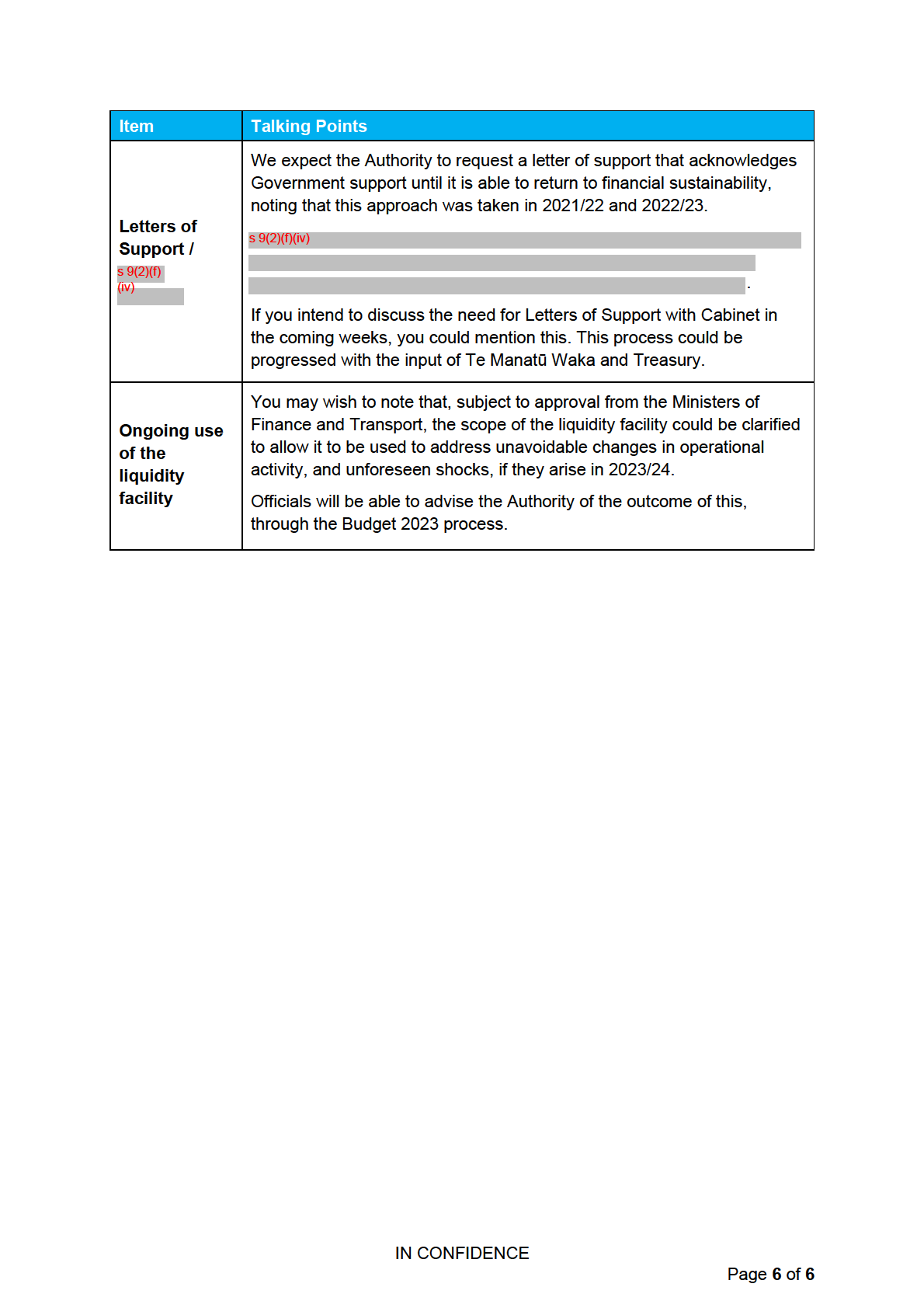
1982
ACT
UNDER
INFORMATION
RELEASED
OFFICIAL
THE


8 September 2022
Janice Fredric
Chair
Civil Aviation Authority
s 9(2)(a)
Tēnā koe Janice
1982
LETTER OF SUPPORT FOR THE 2022/23 AND 2023/24 FINANCIAL YEARS
This Letter of Support is provided to enable the Board of the Civil Aviation Authority (the
ACT
Authority) to determine whether it is appropriate for it to continue to operate on a going
concern basis.
The Government acknowledges that support may be required until the Authority returns to
financial sustainability. Cabinet agreed that it will provide such support until the sector
UNDER
recovers and/or the Authority achieves a pathway back to financial sustainability through the
upcoming funding review (DEV-21-MIN-0192 refers).
We expect ongoing transparency and discipline around such financial support. The Board
has a critical role in monitoring financial performance which includes continuing to identify
opportunities to find cost savings and maximise available capability to meet core statutory
and regulatory commitments.
INFORMATION
The Government is committed to working with the Board over the medium-term in its
endeavour to return the Authority to financial sustainability. We expect the Authority to work
RELEASED
collaboratively with Te Manatū Waka to complete the current funding review by
30 June 2024 and encourage the Authority to seek any additional financial support required
for 2023/24 through Budget 2023.
As part of Budget 2022, Cabinet agreed to provide up to $109.3 million during the 2022/23
financial year to maintain the provision of the Authority’s core functions via an extension of
the “Protection of Transport Sector Agency Core Functions” multi-year appropriation (also
OFFICIAL
known as the liquidity facility). The actual funding provided to the Authority will be the
difference between actual expenditure on core functions (up to the amount budgeted in the
2022/23 SPE) and the actual revenue received in 2022/23, up to $109.3 million.
THE
Cabinet also agreed that, to the extent that actual revenue performs better than expected
and/or costs are lower than budgeted in 2021/22 and 2022/23, any surplus Crown funding
may be made available to fund core functions in 2023/24.



This letter is provided for the above purposes only, is not a guarantee or indemnity, and is
not otherwise intended to create any legal liability on the part of the Crown or any other
person.
Nā māua nei, nā
Hon Michael Wood
Hon Grant Robertson
Minister of Transport
Minister of Finance
1982
Copy to:
Keith Manch, Chief Executive, Civil Aviation Authority
Bryn Gandy, Acting Chief Executive, Te Manatū Waka
ACT
UNDER
INFORMATION
RELEASED
OFFICIAL
THE

IN CONFIDENCE
Document 5
15 March 2023
OC230170
Hon Kiri Allan
Action required by:
Associate Minister of Transport
Wednesday, 29 March 2023
AIR NAVIGATION SYSTEM REVIEW
Purpose
1982
Update you on the Air Navigation System Review and advise you on related meeting invitations
Key points
ACT
• The Government commissioned an independent panel to undertake the Air Navigation
System Review (the review).
UNDER
• The air navigation system comprises the infrastructure, information and services required
for safe flight. As well as larger passenger flights, the system enables access to essential
public services including healthcare via air ambulance services in emergencies, and
routine patient transfers. It is also critical for civil defence and emergency responses across
the nation.
• The panel’s phase 1 report concluded that while the current system is safe and well
regarded, existing policy and regulatory, funding, and institutional settings are not fit for the
INFORMATION
future. Transformational change is required.
RELEASED
• We anticipate the phase 2 report, which will be delivered next month, will recommend that
structures are needed to facilitate more collaboration and strategic thinking across the
system.
• We consider that the recommendations are sound and should be developed further with a
view to implementation. We will report to you in more detail at an appropriate time.
OFFICIAL
• Panel chair, Debbie Francis, met with the previous Associate Minister of Transport prior to
Cabinet considering the phase 1 report, and would welcome an opportunity to meet with
THE
you to present the report.
• Separately, you have been invited by Airways New Zealand to speak at the Airways
New Zealand Safety Forum in Christchurch on 24 May 2023.
IN CONFIDENCE
Page
1 of
8
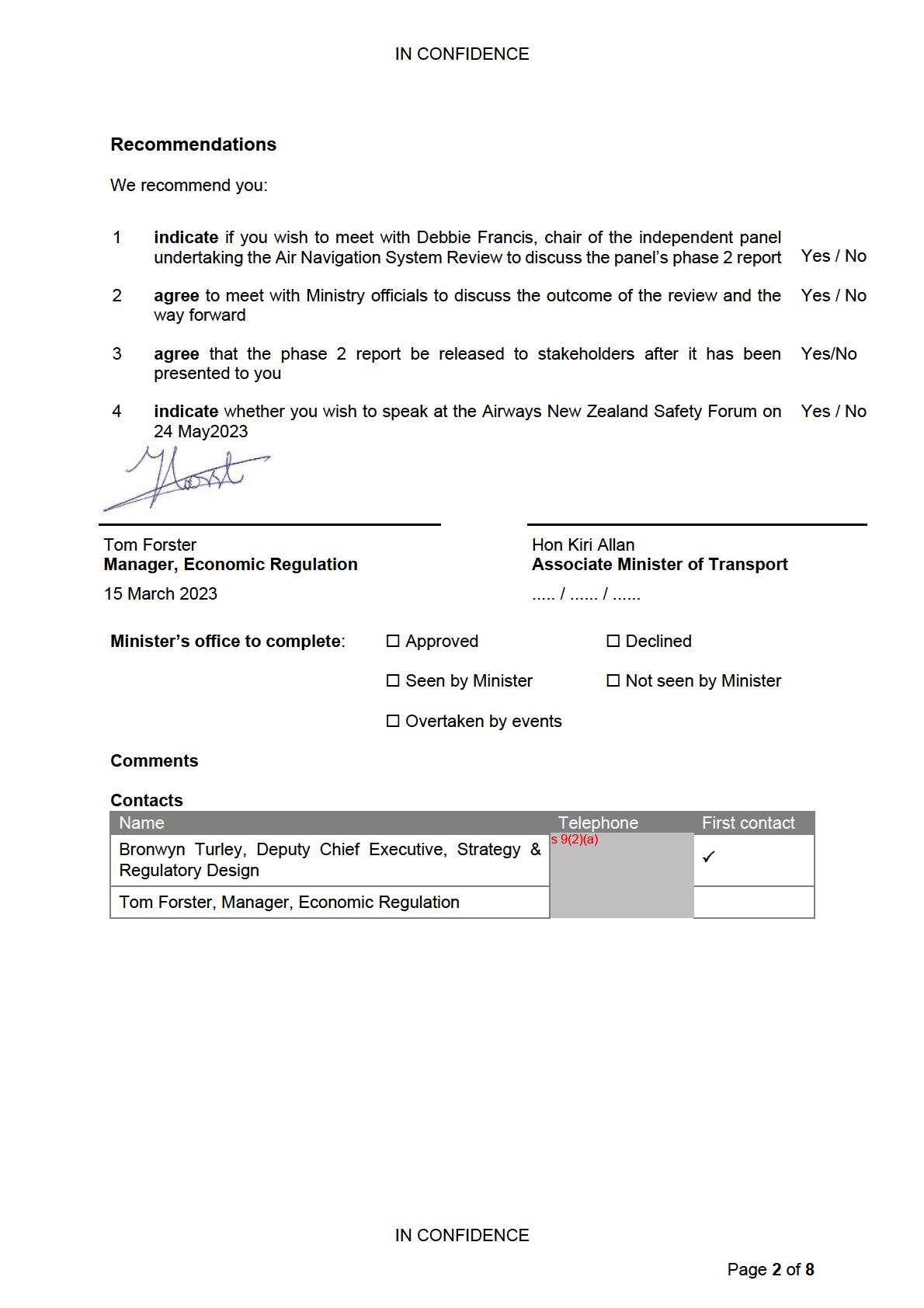
1982
ACT
UNDER
INFORMATION
RELEASED
OFFICIAL
THE
IN CONFIDENCE
AIR NAVIGATION SYSTEM REVIEW
The Air Navigation System is a key part of New Zealand’s infrastructure
1
The air navigation system comprises the infrastructure, information and services
required for safe flight. The system is complex, delivered by a range of agencies,
authorised according to domestic and international standards, and used to guide and
manage aircraft ranging from small recreational drones to international cargo aircraft
and rockets.
2
The system works as an integrated whole, providing the information and infrastructure
for aircraft from the start to the end of a flight. Annex 1 details the core system
components. Annex 2 shows how the core components fit into the wider system.
3
A modern and responsive air navigation system is critical to keeping New Zealand safe,
1982
connected, growing, resilient, and secure. New Zealanders derive significant value
from the system – both direct and indirect. Air transport, trade and tourism contribute
significantly to our society and economy. The direct contribution from air transport alone
in 2019 was valued by the International Air Transport Association at USD$3.7 billion.
ACT
Ninety-nine percent of visitors to New Zealand arrive by air.
4
The system enables access to essential public services including healthcare via air
ambulance services in emergencies, and routine patient transfers. It is also critical for
civil defence and emergency responses across the nation and the wider South Pacific
UNDER
region.
5
The aviation system is innovative, productive and growing. Airspace and aircraft
innovation is expanding the potential for future business activity, foreign direct
investment and productivity growth in New Zealand.
6
A number of challenges and opportunities have arisen with the current air navigation
services. These include:
INFORMATION
6.1
new technologies: airframe materials, autonomous and remotely piloted
RELEASED
aircraft, artificial intelligence, digitalisation, alternative fuels, and new
propulsion systems
6.2
drives for the decarbonisation of aviation
6.3
demands for different design and use of airspace, including low altitude and
urban airspace, and providing for aircraft and launch vehicles transiting to and
OFFICIAL
from space
6.4
emergence of new business models and alternative providers for some
components of the air navigation system
THE
6.5
emerging threats and risks around cyber security and security of physical
infrastructure
6.6
ongoing globalisation of system components
6.7
new international standards and regulations
6.8
movement to performance-based regulation and other regulatory responses to
rapidly changing technology.
IN CONFIDENCE
Page
3 of
8
IN CONFIDENCE
7
Given all of the issues above around the regulatory settings, new technologies,
funding of the system, and integration of air space, most stakeholders, the Ministry
recommended to the Minister of Transport that a first principles review of the system
be undertaken.
The Minister of Transport initiated a review of the system
8
In February 2021, the Minister of Transport initiated a high level, first principles review
of the air navigation system. Cabinet commissioned an independent panel to undertake
a two phase Air Navigation System Review (the review).
9
On 16 May 2022 Cabinet confirmed the review’s terms of reference [CAB-22- MIN-
0177 refers]. The review was asked to define the principles and objectives that describe
what New Zealand needs and wants from the system now and into the future, and to
assess the suitability of the policy and regulatory, institutional, and funding settings for
1982
the system to deliver those outcomes.
10
The Minister of Transport subsequently appointed an independent panel to conduct the
review. The panel comprises Debbie Francis as Chair, with Howard Fancy, Ed Sims,
ACT
and Danny Tuato’o as fellow panel members [APH-22-MIN-0066 refers]. The
independent panel approach was adopted to ensure the review provides an objective
assessment of long-standing government agency and stakeholder concerns with the
system’s existing settings.
UNDER
The panel’s phase 1 report concluded the system is not fit for the future
11
The panel delivered its phase 1 report in September 2022. Cabinet considered the
report on 26 October 2022 and endorsed it as a basis for phase 2 [DEV-22-MIN-0247
refers].
12
The report argued that while the system has served us well to date, it is not fit for the
INFORMATION
future. The rate of change in aviation and air navigation requires transformational
change now and over the long term. With the advent of new technologies and entrants
RELEASED
into the aviation system, the challenge has now become centred on achieving the twin
benefits of greater innovation and improved safety.
13
The report identifies an absence of vision, leadership, and stewardship, resulting in
incremental, single agency responses to what are urgent system-wide challenges.
14
Other states have developed high-level visions and are working with industry to seize
OFFICIAL
the opportunities of new and emerging technologies, and build the capacity and
capabilities in the system to safely deliver future benefits. New Zealand risks being left
behind.
THE
15
Other important findings in the report include:
15.1
There are voices missing from the system. Māori aspirations, te ao Māori
perspectives and partnership with Māori to give effect to Te Tiriti o Waitangi are
absent.
15.2
The regulatory settings need to enable safe integration of new technologies
while maintaining system safety. The panel reports a need to boost regulatory
agility and capability to these ends.
IN CONFIDENCE
Page
4 of
8
IN CONFIDENCE
15.3
A more deliberate and planned investment in the future system will be required.
While the user-pays model will continue, there is also a need to consider more
transparent, sustainable and equitable funding, and charging approaches.
You will receive the phase 2 report next month
16
The panel is finalising its phase 2 report which it is due to present to you next month.
Based on information shared with an industry reference group in a series of workshops,
we anticipate recommendations along the following lines:
1. Implement a national air navigation system strategy to set priorities and drive action
2. Establish a Governance Council to steer system-wide transformation
3. Develop a shared set of system-level performance metrics to hold leaders to
1982
account
4. Invest in critical system components to preserve and enhance national security and
resilience
ACT
5. Maintain user-pays for current operations and explore new funding and investment
streams for R & D and innovation
UNDER
6. Develop robust international partnerships for economies of scale and innovation
7. Identify Māori rights and interests and opportunities for Māori-Crown partnership
8. Accelerate the transition to a more anticipatory and performance-based regulatory
framework.
INFORMATION
The chair of the panel would welcome the opportunity to present the report to
you
RELEASED
17
Debbie Francis, the chair of the panel, met with the previous Associate Minister of
Transport to present the phase 1 report. She would welcome the opportunity to meet
with you to present and discuss the phase 2 report.
OFFICIAL
We consider that the recommendations merit further investigation
18
Subject to any changes in the final report, we consider that all the panel’s
recommendations merit further investigation with a view to implementation.
THE
19
There is no current statement of direction for the system. The most recent national
policy statement on aviation is the National Airspace Policy of New Zealand, published
in 2012. Without that foundation, it is difficult to determine if the system meets our
current and future needs.
20
The recommendations have, in general, been well received by the stakeholder
reference group. Industry also gave feedback to the panel about the importance of a
focus on workplace issues.
IN CONFIDENCE
Page
5 of
8
IN CONFIDENCE
21
Some industry participants will take the view that the recommendations do not go far
enough in that the panel will not recommend a change to the State Owned Enterprises
form of Airways. The panel has clearly communicated this view to stakeholders in the
phase 1 report and during discussions in phase 2.
22
We consider that a strategic, system-wide, approach to the future will achieve more
lasting results than tweaking the corporate form of any one participant.
23
Recommendations 1 and 2 are foundational actions, from which the understanding
necessary to implement the other actions will follow. Other actions will need to draw
both on thinking that emerges from a strategy and on work already underway.
24
We would expect, for example, that an advisory group and those drawing up a strategy
would draw on work being done by the Department of Prime Minister and Cabinet and
the National Emergency Management Agency in understanding what critical and
resilient infrastructure looks like, and work in the context of the Regulatory Framework
1982
Review Programme (Trifecta).
Cabinet approval will be necessary to implement some recommendations
ACT
25
While all participants in the system will need to buy in to any future direction, the
government has a crucial role to play as policy maker, regulator, funder, and owner.
26
Any substantive response to the review will therefore require further Cabinet decisions.
UNDER
Some of the changes required will be medium and long-term projects that will draw on
resources from a number of government agencies. A more coherent view about which
components of the system are public goods which cannot be maintained through user
pays is a strategic decision, which could have funding implications. The panel’s call for
collaborative action will be strengthened by support from the range of Ministers with
portfolio interests in the system, and the sectors that depend on and/or benefit from it.
27
There are stakeholder expectations that Cabinet will consider the phase 2 report in May
INFORMATION
2023, soon after it is presented. Given government priorities and departmental
resources, we consider that this timeframe is not feasible. Fully developing the strategy
RELEASED
would require additional resources which could be the subject of a future Budget bid.
28
We propose undertaking work in consultation with other government agencies on
scoping an initial response to the recommendations. We will report to you in more
detail on potential steps to advance the foundation actions in particular, towards the
end of the year.
OFFICIAL
We recommend you release the report
29
Once the Panel has presented its report to you we suggest releasing it to stakeholders
THE
to recognise the high degree of stakeholder interest and involvement in the review.
30
In releasing the report you could advise stakeholders that you have asked the Ministry
of Transport for advice on advancing the recommendations for later in the year.
You have also received a speaking invitation from Airways New Zealand
31
Airways has invited you to be a keynote speaker at the 2023 Airways New Zealand
Safety Forum being held in Christchurch on Wednesday, 24 May 2023.
IN CONFIDENCE
Page
6 of
8
IN CONFIDENCE
32
The Forum could provide a valuable opportunity for you to hear from the sector ahead
of making any decisions. However, as you will not have anything substantive to
announce, and given other matters you are focussing on, we consider attendance is
low to medium priority.
1982
ACT
UNDER
INFORMATION
RELEASED
OFFICIAL
THE
IN CONFIDENCE
Page
7 of
8
IN CONFIDENCE
ANNEX 1: AIR NAVIGATION SYSTEM COMPONENTS
CNS – communication, navigation, and surveillance
Communication refers to communication between two or more aircraft, the exchange of data
or verbal information between aircraft and air traffic control and the ground-based
communication infrastructure of the air traffic management network. Navigation is the planning,
recording, and controlling the movement of an aircraft from one place to another by providing
accurate, reliable, and seamless position determination capability. Navigation includes the use
of dedicated ground and satellite technology and performance-based navigation (PBN).
Surveillance systems are used by air traffic control to determine the position of aircraft.
Systems on the ground communicate with equipment on board the aircraft to determine the
1982
position and other details of each aircraft.
ATM – Air traffic management
ACT
ATM is the integrated management of air traffic and airspace. ATM comprises the following
components: air traffic services (ATS), airspace management (ASM) and air traffic flow
management (ATFM).
Meteorological services for air navigation
UNDER
System providers internationally provide aviation weather services through the distribution of
aviation weather reports and forecasts for route planning and for use by controllers. MetService
is the primary provider of aviation forecasting in New Zealand.
Aeronautical information services/Aeronautical information management
AIS/AIM is the integrated management of aeronautical information services through the
INFORMATION
provision and exchange of quality-assured digital aeronautical data. This provision and
exchange of data ensures the flow of information necessary for the safety, regularity, and
RELEASED
efficiency of international air navigation.
Aerodromes and ground aids (AGA)
Aerodrome infrastructure is a key component that influences air traffic flows and system
capacity. AGA includes the following elements: aerodrome certification, visual aids for
OFFICIAL
prevention of runway incursions, visual aids for denoting wind turbines, advanced aircraft
docking systems to improve apron safety, rescue and firefighting provisions, wildlife strike
hazard reduction, and heliports.
THE
Airspace design
Aotearoa New Zealand includes airspace design as part of the domestic system for planning
purposes. Technological developments, including those in the core system, require airspace
design and designations to be continuously reviewed to accommodate increasing traffic, new
types of aircraft and more direct and efficient flight paths.
IN CONFIDENCE
Page
8 of
8

1982
ACT
UNDER
INFORMATION
RELEASED
OFFICIAL
THE
 EVENT BRIEFING
EVENT BRIEFING
Document 6
23 March 2023
OC230193
Hon Kiri Allan
Associate Minister of Transport
cc Hon Michael Wood
Minister of Transport
SUSTAINABLE AVIATION AOTEAROA 2023
1982
Snapshot
ACT
•
At the officials’ meeting on 14 March 2023, you agreed to host the upcoming second
quarterly Sustainable Aviation Aotearoa (SAA) hui at Parliament on 4 April 2023 and
provide opening remarks. You also requested a package of background reading. This
briefing provides:
UNDER
o
Relevant context about SAA and an outline of Te Manatū Waka’s proposed
approach to the group in 2023 (main briefing)
o
Speaking notes for your opening remarks (Annex 1)
o
A draft agenda for the meeting and list of members of the SAA leadership
body (Annex 2)
INFORMATION
o
Background reading as requested (Annex 3)
RELEASED
•
The establishment of SAA (a public-private leadership body to decarbonise aviation)
is an Emissions Reduction Plan (ERP) action and a cornerstone of the Ministry’s
sustainable aviation work.
•
Your presence at the first hui of 2023 will emphasise the importance of the group to
OFFICIAL
the Government and help to set the tone for the year ahead. Please see Annex 1 for
suggested speaking notes.
•
You are not expected to attend SAA hui on a regular basis, but we think meeting the
THE
group soon after your appointment as Associate Minister is a good opportunity to for
you to meet key representatives of the aviation industry and familiarise yourself with
some of the key challenges and opportunities with aviation decarbonisation. You are
however welcome to attend the group’s future meetings at any time.
•
In future, we will update you about the work of SAA via the weekly report or in longer
briefings as necessary.
UNCLASSIFIED
Page
1 of
15
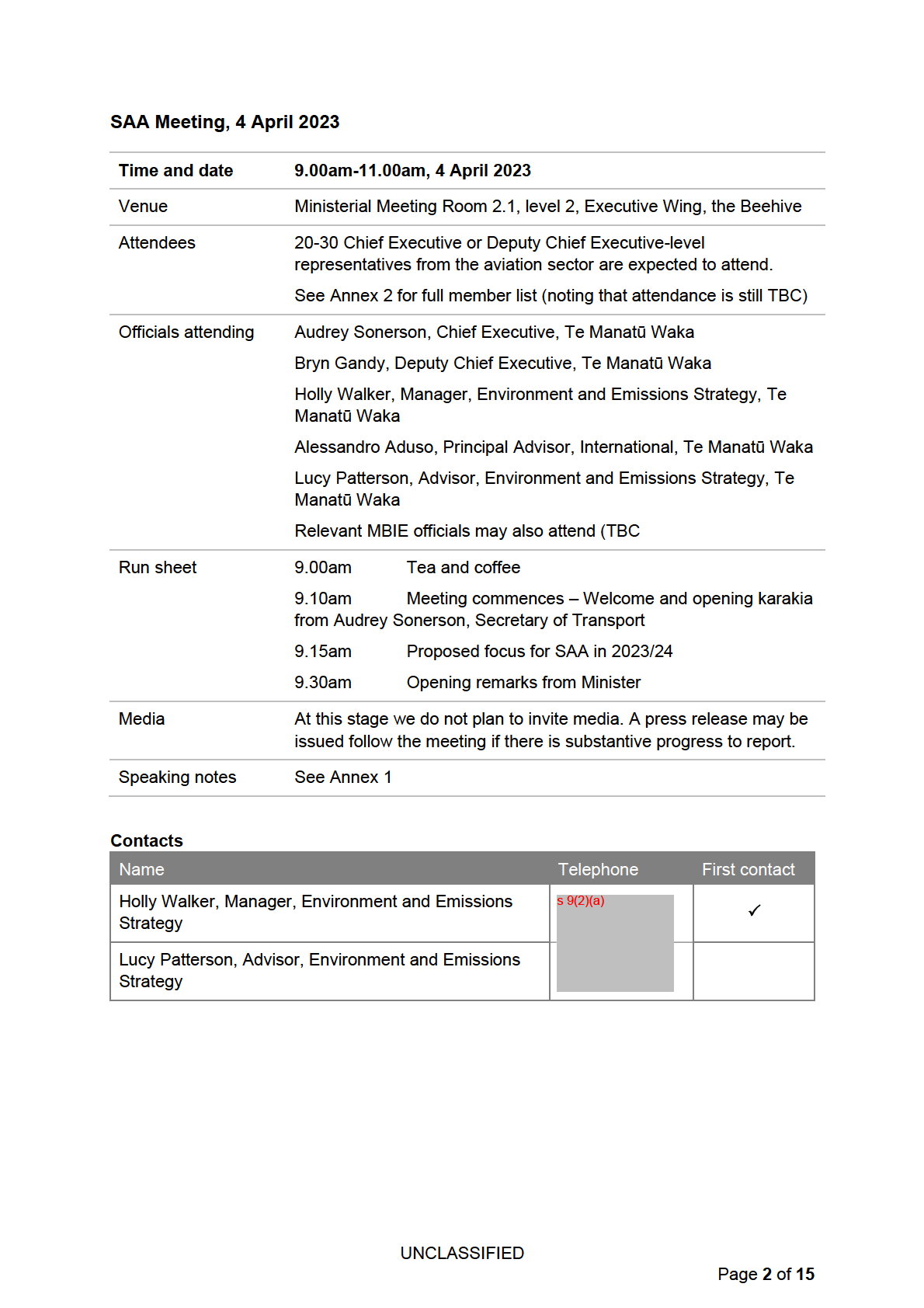
1982
ACT
UNDER
INFORMATION
RELEASED
OFFICIAL
THE
SUSTAINABLE AVIATION AOTEAROA 2023
Context
1
In November 2022, Te Manatū Waka (the Ministry) convened the inaugural SAA hui.
Ministers McAnulty (your predecessor) and Verrall (Research, Science, and Innovation)
attended, along with airline, airport and pilots’ association executives and relevant
officials. Minister Woods (Energy and Resources) was to attend but gave apologies
due to another commitment.
2
The inaugural SAA hui focused on introductions, reaching agreement on the Terms of
Reference (ToR) for the group, agreeing on the establishment and focus areas for three
working groups, and suggestions for additional membership.
1982
1
The following three working groups were agreed upon at the first SAA meeting:
• Sustainable Aviation Fuel (SAF), with a particular focus on exploring the policy
ACT
settings for a SAF mandate, cost, importation, and production
• Zero-Emissions Aviation, including hydrogen and electric aircraft and its
enabling infrastructure
UNDER
• Strategic policy, which will consider the ERP action to establish domestic
emissions reductions targets, update the New Zealand State Action Plan for
aviation, and assist the CCC with their consideration of including international
aviation emissions within our domestic targets.
3
According to the ToR, SAA meetings will occur quarterly. The second meeting was due
to be held in February 2023 but was postponed while we awaited clarity on Ministerial
INFORMATION
delegations.
RELEASED
4
Since the inaugural hui, we have continued regular informal discussions with members
of the group, including Air New Zealand who are strong advocates of sustainable
aviation and supportive of SAA, and with our counterparts at MBIE.
5
Two new SAA members have been added since the first meeting: Airways and Airbus.
We have also extended an invitation to Boeing but are yet to receive confirmation of
OFFICIAL
whether or not they will take this up.
Relationship of SAA to the ERP and our international obligations
THE
6
The first Emissions Reduction Plan (ERP) established three key actions for
decarbonising aviation:
• Establish a public-private leadership body focused on decarbonising aviation,
including operational efficiencies, infrastructure improvements, and frameworks to
encourage research, development and innovation in sustainable aviation (this has
now been actioned with the establishment of SAA).
UNCLASSIFIED
Page
3 of
15
• Develop and set specific targets for decarbonising domestic aviation in line with our
2050 targets.
• Implement a SAF mandate.
7
New Zealand is also a member state of the International Civil Aviation Organisation
(ICAO), which has had an increasing focus on aviation decarbonisation in recent years.
8
ICAO member states are invited to submit State Action Plans (SAPs) and update them
every three years. SAPs are designed to help Member States establish a long-term
strategy on climate change for the international aviation sector, involving all interested
parties at national level.
9
ICAO encourages these parties to work together to define a quantified baseline
scenario, select appropriate emissions mitigation measures, and calculate the
1982
expected results of implementing those measures.
10
New Zealand submitted its first SAP in 2016. We are currently overdue to provide an
ACT
updated version.
11
In line with ICAO’s guidance to Member States to work with aviation stakeholders to
progress decarbonisation, officials plan to propose at the 4 April meeting that SAA
focuses its 2023 agenda on developing and agreeing content for New Zealand’s next
UNDER
ICAO SAP, with each of the three proposed SAA working groups contributing to
relevant sections.
2
Making the SAP the focal point for SAA in 2023 serves multiple functions:
• Advancing all the aviation actions in the ERP
INFORMATION
• Developing an evidence base and supporting material to inform the Climate
Change Commission’s upcoming advice on whether to include international
RELEASED
aviation emissions in our domestic emissions budgets
• Flagging potential emerging challenges and opportunities with aviation
decarbonisation, including tourism and trade implications.
• Enhancing New Zealand’s international reputation as a high-ambition country in the
OFFICIAL
aviation decarbonisation space (since the SAP is an internationally recognised
document and 136 states are members of ICAO).
•THE
Ensuring key parties are involved in framing up a plan that will have strategic
importance to both the aviation sector and government for at least three years
• Building a strong case for the critical role of aviation from an “NZ Inc” perspective
i.e., not only as a standalone sector but highlighting its vital role as a facilitator and
connector for trade and the tourism sector for a small, remote country like ours.
3
We discussed this proposal with officials from MBIE’s Innovative Partnerships team
as well as with Air New Zealand. Both are both strongly supportive.
UNCLASSIFIED
Page
4 of
15
4
As part of that conversation, Air New Zealand raised the importance of linking the
work of SAA with broader policy programmes such as feeding outputs from the SAP
into the second Emissions Reduction Plan (2026 – 2030) and other related policy
decisions. We agree that this will be important.
To get work on the SAP underway, we propose establishing the SAA working groups late
April/early May
5
Standing up the three working groups could involve asking for nominees from the
core leadership body at the upcoming hui. We want to clearly articulate the need for
dedicated resource to these working groups, so membership will likely be conditional
based on a certain level of compulsory attendance across the year.
1982
ACT
UNDER
INFORMATION
RELEASED
OFFICIAL
THE
UNCLASSIFIED
Page
5 of
15
ANNEX 1: Speaking Notes
SUSTAINABLE AVIATION AOTEAROA HUI APRIL 4 2023
Welcome
• Greet all attendees as appropriate.
• I am thrilled to be here today to open the first Sustainable Aviation Aotearoa hui of
2023.
Aviation plays a critical role in connecting Aotearoa both inter-regionally and across
the globe
1982
• As a country, we rely on aviation as an enabler of:
o timely carriage of our high-value goods to access key markets and contribute
ACT
sizeably to our GDP, carrying about 16 percent of our exports and 22 percent
of our imports by dollar value
o travel, whether for leisure/tourism, business or to connect whanau across the
country and the world.
UNDER
• Due to our relative isolation as a country, aviation plays a particularly critical and
irreplaceable role in the transport system and will continue to for many years to
come.
We know that there are rising global and local pressures that present both significant
challenges, but also great opportunities for improving the way we approach aviation
INFORMATION
in Aotearoa
RELEASED
• The impacts of climate change are already very real, as evidenced by the recent
historic weather events in Aotearoa.
• Such events demand a kind of resilience and tenacity at a scale that we have rarely
seen but will increasingly witness in the coming years.
OFFICIAL
• I want to acknowledge the incredible mahi of yourselves and your organisations
during what was a hugely challenging and unprecedented time.
• Even through such events, there is a dedication to upholding high standards across
THE
the sector, and mucking in when needed, and I see this translating into passion and
commitment towards climate action.
Decarbonising aviation is key to ensuring Aotearoa continues to have access to the
world for years to come
• Last year, New Zealand successfully pushed for the 41st ICAO Assembly to adopt
a long-term global aspirational goal for international aviation of net-zero carbon
emissions by 2050 in support of the UNFCCC Paris Agreement's temperature goal.
UNCLASSIFIED
Page
6 of
15
Reflective of the need to take this journey together, some of you were in Montreal
to witness this historic agreement.
• Within the SAA group, we are not short on ambition.
o For example, Air New Zealand has set a 2030 interim science-based target,
validated by the Science Based Targets initiative, to reduce carbon intensity
by 28.9% by 2030, from a 2019 baseline.
o Air NZ and Qantas both have an ambitious and major goal of reaching 10%
SAF use by 2030. I was pleased to hear that, to his end, Air NZ procured its
first SAF shipment last year.
• However, ambition alone wil not carry us. I can’t understate the importance of
collaboration to deliver. No one of us can go it alone. We need to pull our sleeves
1982
up and work together now to make net zero a reality.
Final thoughts
ACT
• The challenges ahead are daunting, but I am encouraged by the collaborative
approach SAA endeavours to take.
• I thank my fellow Ministers, Hon Drs, Woods and Verrall for jointly sponsoring this
UNDER
important work and reminding us that this is not just about aviation, but about how
it fits into the broader New Zealand and global context.
• And I thank you all for showing up and playing your part.
• Thank and conclude remarks as appropriate.
ENDS
INFORMATION
RELEASED
OFFICIAL
THE
UNCLASSIFIED
Page
7 of
15

1982
ACT
UNDER
INFORMATION
RELEASED
OFFICIAL
THE
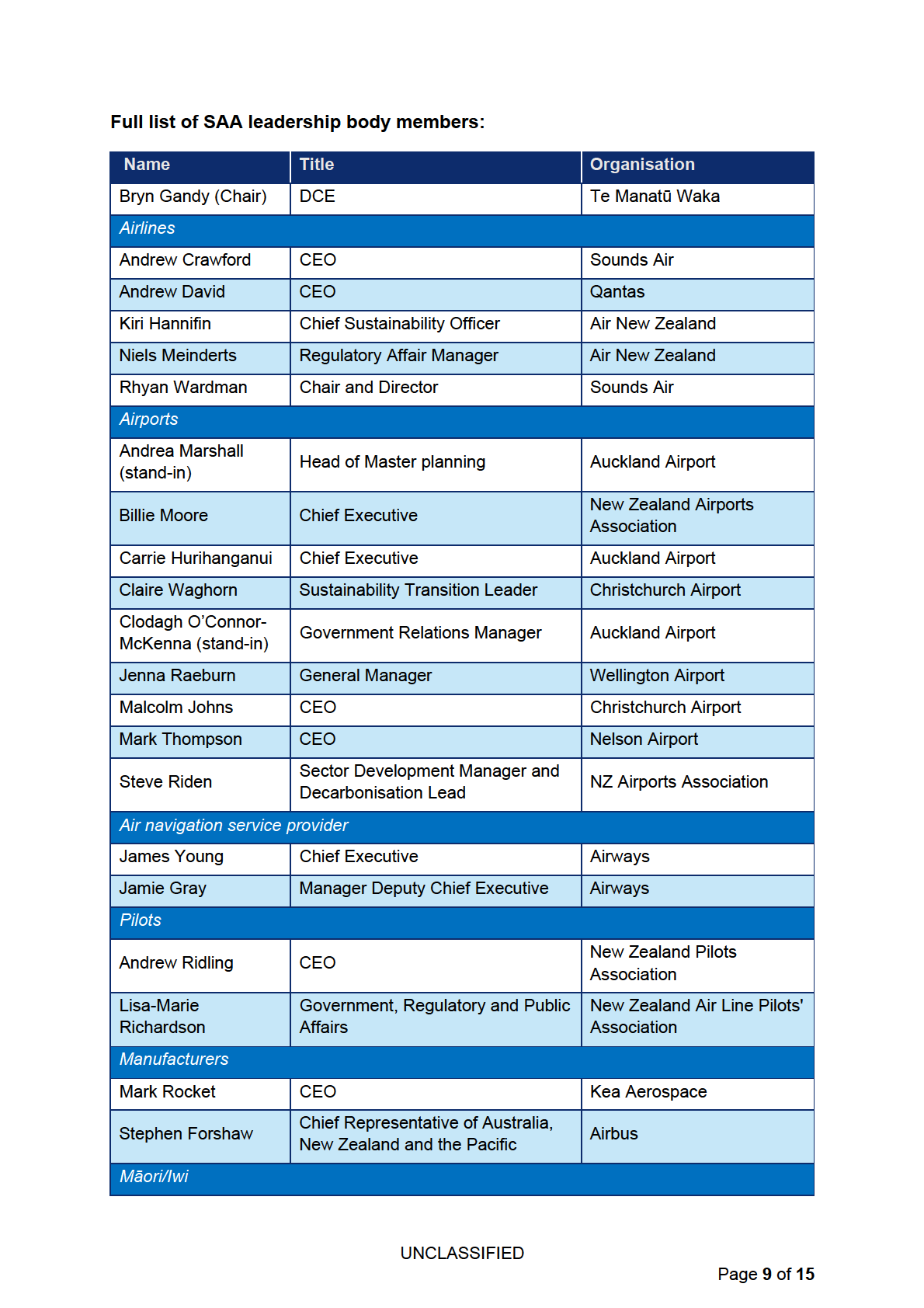
1982
ACT
UNDER
INFORMATION
RELEASED
OFFICIAL
THE

1982
ACT
UNDER
INFORMATION
RELEASED
OFFICIAL
THE
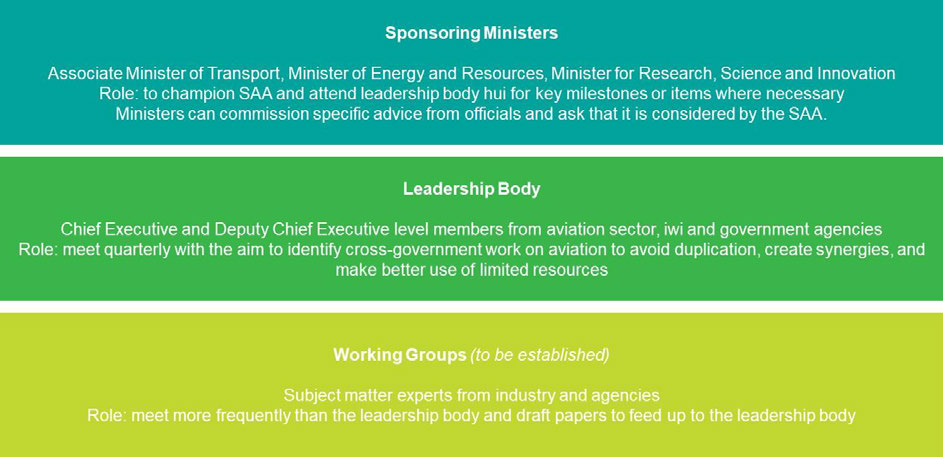 ANNEX 3: Background information
Sustainable Aviation Aotearoa (SAA) gives effect to an action in the Emissions
ANNEX 3: Background information
Sustainable Aviation Aotearoa (SAA) gives effect to an action in the Emissions
Reduction Plan (ERP)
SAA heeds the ERP action to establish a public-private leadership body focused on
decarbonising aviation
1
Establishing a public-private leadership body "focused on decarbonising aviation,
including operational efficiencies, infrastructure improvements and frameworks to
encourage research, development and innovation in sustainable aviation", was
included in the ERP under Action 10.3.3.
2
The ERP also includes actions to implement a sustainable aviation fuel (SAF) mandate,
1982
and to set domestic emissions reductions targets for aviation. The Climate Change
Commission (CCC) is to review the inclusion of international aviation emissions in our
domestic targets by 2024, as directed by the Climate Change Response Act 2002. It
will be important to work with industry on these actions.
ACT
3
The SAA leadership body comprises Chief Executive or Deputy Chief Executive-level
representatives to provide governance and strategic direction, and influence actions
within their own organisation.
UNDER
4
Acknowledging the energy sector implications of sustainable aviation, and significant
need for technological and innovative advancements, SAA is jointly endorsed by the
Associate Minister of Transport, Minister of Research, Science and Innovation, and the
Minister for Energy.
5
See Annex 2 for a list of current members.
INFORMATION
SAA: Roles and responsibilities
RELEASED
OFFICIAL
THE
UNCLASSIFIED
Page
11 of
15
SAA provides advice on the government and the sector’s ambitions for low-and zero-
emission aviation
6
SAA aims to identify cross-government work on aviation to avoid duplication, create
synergies, and make better use of limited resources. In part, this will be achieved
through SAA establishing working groups to accelerate progress on decarbonising
Aotearoa's aviation sector.
7
The leadership body does not have any decision-making powers; these lie with the
SAA sponsoring Ministers as relevant to their respective portfolio responsibilities. The
core body is a policy reference group that reports to officials, who then pass on
information or recommendations to Ministers as needed.
8
The Ministry Deputy Chief Executive Bryn Gandy chairs the SAA Leadership Body,
which convenes quarterly.
1982
9
At the inaugural SAA hui in November 2022, the following three working groups were
agreed upon:
ACT
• SAF, with a particular focus on exploring a SAF mandate, cost, importation, and
production
• Zero-Emissions Aviation, including hydrogen and electric aircraft and its
enabling infrastructure
UNDER
• Strategic policy, which will consider the ERP action to establish domestic
emissions reductions targets, update the New Zealand State Action Plan for
aviation, and assist the CCC with their consideration of including international
aviation emissions within our domestic targets.
10
More broadly, SAA links to the ambitions outlined in the draft national aerospace
INFORMATION
strategy. In September 2022, your predecessor, Minister McAnulty jointly released
consultation document on a national aerospace strategy with the Minister for Economic
RELEASED
and Regional Development and the Minister for Research, Science and Innovation.
Goal one of that strategy is to “build a sustainable air passenger journey” by 2030.
Despite SAA’s relative infancy, there is already significant buy-in from key agencies and
industry players OFFICIAL
11
In establishing SAA, the Ministry considered what options were available in consultation
with the Ministry for Business, Innovation and Employment (MBIE) and Air New
Zealand - who advocated for the establishment of the SAA and provided proposals to
Ministers and officials.
THE
12
Air New Zealand has expressed and reiterated support of the SAA initiative. They see
SAA as playing a critical role in breaking down silos, both at the interagency level, but
also between industry players, and government.
13
Since the inaugural hui, Airways and Airbus contacted the Ministry under their own
volition to request membership in the SAA leadership body.
UNCLASSIFIED
Page
12 of
15
Internationally, there are other examples of Government led sustainable
aviation groups
14
New Zealand aviation industry participants regularly refer to international examples of
successful, private-public aviation decarbonisation partnerships, which the New
Zealand SAA can learn from. These are listed below, for your reference:
•
United Kingdom’s Jet Zero Council is a forum bringing together government,
industry, and academia to speed up the aviation green transition. The Council
was established in 2020, to work with the aviation industry towards achieving
net zero in aviation and developing sustainable aviation fuels (SAF) facilities in
the UK.
•
Singapore’s International Advisory Panel (IAP) on a Sustainable Air Hub was
formed in February 2022 and brings together industry, technology, and
1982
knowledge partners from Singapore and around the world to discuss how
international aviation can be made more sustainable and accessible for all, and
how Singapore can contribute to this international effort. ACT
•
Australia’s Jet Zero-style Council is part of the Federal Government’s efforts to
collaborate with the industry to achieve a sustainable aviation sector that
supports emission reduction targets en-route to net zero by 2050. In February
2023, representatives from various sectors of the aviation industry attended an
UNDER
Industry Roundtable, to discuss the establishment and objectives of the Council.
Key international aviation trends and emerging issues
15
Aviation accounts for over 2 percent of global energy-related CO2 emissions, having
grown faster in recent decades than road, rail, or shipping.
16
Over the next 20-30 years, interim solutions are needed until more advanced
INFORMATION
technologies (such as hydrogen aircraft - that are truly net-zero), have reached
maturation, if we are to reach to net-zero aviation by 2050.
RELEASED
17
ICAO outlines a basket of measures necessary to decarbonise aviation:
• Aircraft technologies
• Operational improvements
OFFICIAL
• Sustainable aviation fuels
• Carbon offsetting
THE
UNCLASSIFIED
Page
13 of
15
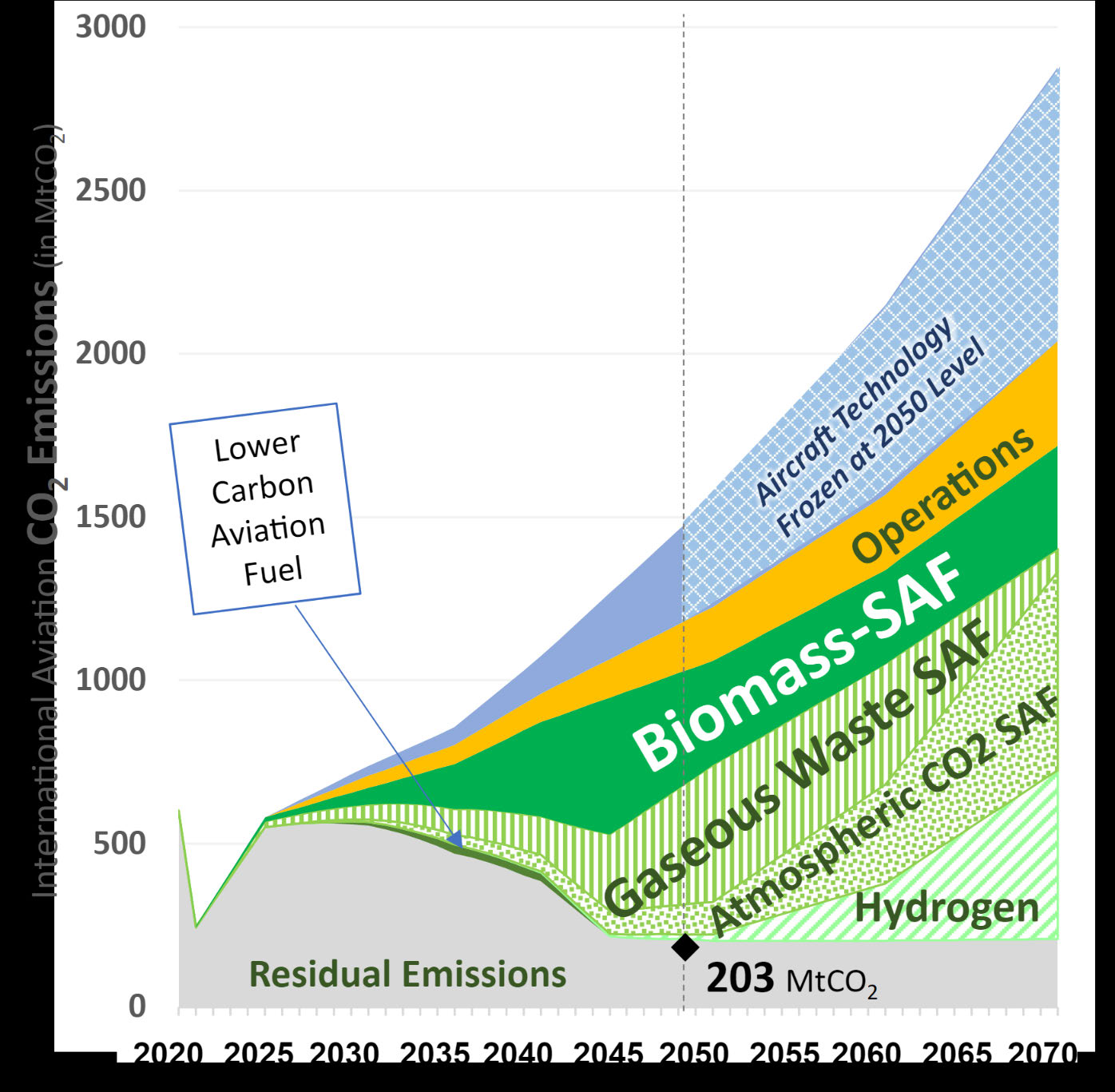
18
The following ICAO chart depicts the relative makeup and phasing of decarbonisation
measures:
1982
ACT
UNDER
INFORMATION
RELEASED
19
The chart highlights sustainable aviation fuel (SAF) as the most viable solution for long
haul aviation for the next 20-30 years. However, there are significant challenges with
the procurement, production, and cost of SAF, as demand grossly outstrips supply.
OFFICIAL
• From the perspective of the purchaser (i.e., airlines such as Air New Zealand)
SAF poses sizeable operational costs, with estimates putting SAF at anywhere
between 2-10 times the cost of existing jet fuel.
THE
• Beyond pricing issues, there are other broader considerations regarding the
sustainability and ethics behind the different feedstocks.
20
Another interim decarbonisation measure is the Carbon Offsetting and Reduction
Scheme for International Aviation (CORSIA). CORSIA complements the other
elements of the basket of measures by offsetting the amount of CO2 emissions that
cannot be reduced through technological improvements, operational improvements,
and sustainable aviation fuels with emissions units from the carbon market.
UNCLASSIFIED
Page
14 of
15
21
With current understanding of technology, electric aircraft may only be able service
short-haul flights and hydrogen aircraft (for longer distances) are unlikely to be viable
until the second half of the century. However, in Aotearoa, Air New Zealand is
investigating hydrogen and electric aircraft options for short-haul flights on their journey
to start replacing their short-haul fleet by 2035.
22
Given New Zealand’s relative isolation, and currently limited scope to produce
commercial quantities of SAF or develop electric/hydrogen aircraft, working with our
international counterparts is critical to reaching our net-zero ambitions.
1982
ACT
UNDER
INFORMATION
RELEASED
OFFICIAL
THE
UNCLASSIFIED
Page
15 of
15
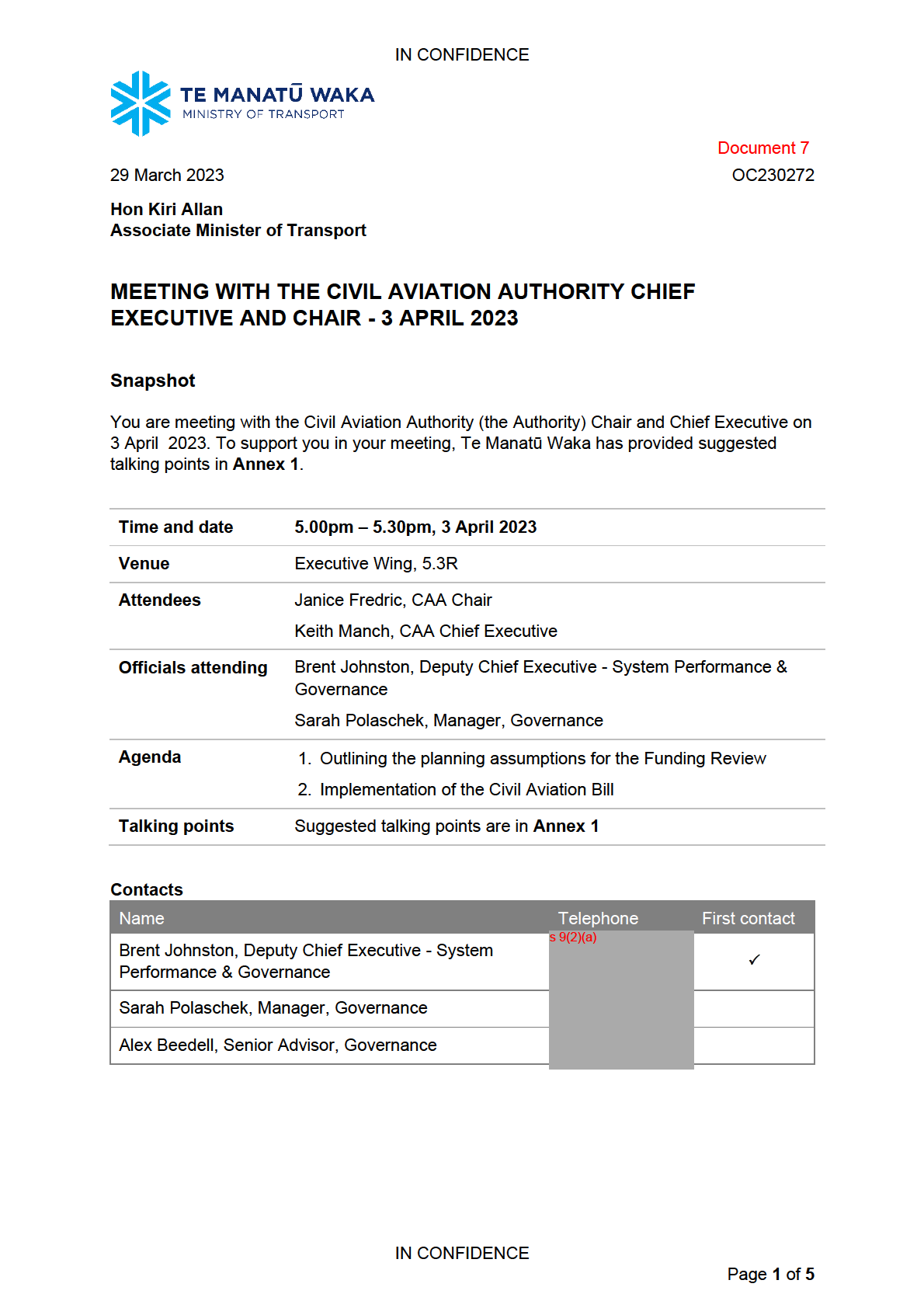
1982
ACT
UNDER
INFORMATION
RELEASED
OFFICIAL
THE
IN CONFIDENCE
MEETING WITH THE CIVIL AVIATION AUTHORITY CHIEF
EXECUTIVE AND CHAIR - 3 APRIL 2023
Key points
• You are meeting with Janice Fredric (Chair) and Keith Manch (Chief Executive) of the Civil
Aviation Authority (the Authority) on 3 April 2023.
• This is the first of your regular meetings with the Authority’s Chair and Chief Executive
since you took up your delegation. As this is your first time meeting the CAA Chair, we
have provided, for your reference,
Ms Fredric’s biography on
page 5.
• The Authority provided its meeting advice to your office on 28 March 2023, which sets out
two proposed agenda items:
outlining the planning assumptions for the funding review and
1982
the
implementation of the Civil Aviation Bill. Context for these topics is provided on
pages
3 – 4.
We recommend that you set your expectations and priorities for the Authority in 2023/24
ACT
• The Authority has not yet received a Letter of Expectations for 2023/24, but continues to
prepare a draft Statement of Performance Expectations (SPE) to meet the 30 April 2023
statutory deadline i.e., the date when the draft must be provided for your feedback.
UNDER
• Officials have advised the Authority to prepare the SPE as though all its Budget 2023
initiatives were successful, with the aim of seeking decisions from you (through the SPE
approval process) on the expectations and priorities that should be progressed in the next
financial year if the Authority’s bid, or aspects of the bid, are unsuccessful.
• We suggest that you use your meeting to set expectations and priorities for the Authority
in 2023/24. This will enable the Authority to reflect your views in the draft SPE, and to begin
INFORMATION
work to identify options that would enable Ministerial expectations to be met - while
delivering the Authority’s core safety and security functions
RELEASED
- if its Budget bid is
unsuccessful.
You may also wish to discuss Board reappointments with the Chair
• The terms of the
Chair and Board member,
Charles Spillane, expired on 2 December
2022. Both have confirmed their interest in being reappointed and have accepted a request
OFFICIAL
to stay on the Board until their reappointment is confirmed or a successor has been found.
In addition,
Hon Harry Duynhoven’s term will expire on 30 June 2023, and he has
confirmed his interest in being reappointed.
THE
• As noted in the weekly report for the week ending 31 March 2023, officials have reviewed
the findings from the Authority’s recent board evaluation, which found the Board is
performing satisfactorily and has a good understanding of its strengths, areas to improve
and priorities over the coming year.
• Strengths were identified as Board culture, performance (organisational, regulatory, and
financial), and the Board’s constructive relationship with the Chief Executive. However,
there were opportunities for the Board to:
IN CONFIDENCE
Page
2 of
5
IN CONFIDENCE
o continue refining the focus, quality and volume of information reported to the Board;
o continue focusing at a strategic governance level, as opposed to an operational
management level;
o undertake long-term strategic planning, depending on funding.
• The results also showed the Board is satisfied with the Chair’s performance overall and
appreciate her positive relationships with members, the Chief Executive, and
stakeholders.
• We suggest that you do not confirm reappointment decisions at this meeting, but note that
you have recently taken up the delegation and will consider Board reappointments shortly.
However, you may wish to seek the Chair’s view on the reappointments of the two
members, in light of the board evaluation’s findings.
1982
• We note that often reappointment discussions are held privately, between the responsible
Minister and Chair, to enable a free and frank discussion on the performance of the Board,
and Board members.
ACT
• Suggested talking points for Board reappointments, and the two agenda items, are
provided for your consideration in
Annex 1.
Item one: Outlining the planning assumptions for the funding review
UNDER
1. s 9(2)(f)(iv)
2. The liquidity facility has been in use since 2020 and bridges the gap between forecast
levy revenue and actual revenue. Subject to Budget 2023 outcomes, funding through
INFORMATION
the liquidity facility may be extended into 2023/24, but (at present) there is no guarantee
of Crown funding beyond this financial year.
RELEASED
3. Additional Crown funding is required to enable delivery of the Authority’s core safety
and security functions, as current levy rates are unable to recover the cost of the
services provided.
4. The Authority is aware that Te Manatū Waka is preparing a paper for Cabinet’s
consideration in May 2023, regarding
OFFICIAL s 9(2)(f)(iv)
, and
expected out-turns for future financial years. It is expected that a draft of this paper will
be provided to you for feedback on 31 March 2023, with the view that the finalised
paper is considered by Cabinet on 3 May 2023.
THE
5. In consideration of the points above, and the Authority’s meeting advice which notes
its concern around s 9(2)(g)(i)
’ you may
wish to use this meeting to:
5.1 note your comfort providing a letter of support to the Authority, s 9(2)(f)(iv)
s 9(2)(f)(iv)
5.2
IN CONFIDENCE
Page
3 of
5
IN CONFIDENCE
s 9(2)(f)(iv)
5.3
5.4
6. The Authority’s meeting advice also notes that re-instating operational reserves is an
area of concern. In OC230082 you agreed that the Authority may:
6.1 use the liquidity facility in 2023/24 to address unforeseen shocks and unavoidable
changes in operational activity, subject to the Ministers of Finance and
Transport’s approval of financial recommendations for Budget 2023; and
1982
6.2 partially restore its reserves from 1 July 2024 using surplus liquidity facility
funding from 2023/24.
s 9(2)(f)(iv)
ACT
7.
UNDER
Item two: Implementation of the Civil Aviation Bill (CAB)
8. Officials are broadly supportive of the advice provided by the Authority on this item.
9. Although the Authority’s meeting advice suggests that no decisions are sought on CAB
during your meeting, we consider that the context provided is helpful in advance of the
INFORMATION
decisions that will be required from you in the short-term.
RELEASED
10. You may wish to use this meeting to understand what decisions will be required from
you in the short-term as well as the timelines for those decisions; and to note your
requirements when being asked to make decisions such as the level of detail in the
Authority’s advice.
11. Te Manatū Waka wil provide you with advice on the implementation of the Bill, and
OFFICIAL
decisions that you be asked to make, following CAB’s progression through the
Committee of Whole House and Third Reading.
THE
IN CONFIDENCE
Page
4 of
5

IN CONFIDENCE
Biography
Janice Fredric
Janice is a professional director with over 20 years governance
experience. She has a broad portfolio of current and past
directorships with significant experience in commercial, public
sector and not-for-profit sectors. In addition to her role as CAA
Board Chair, she is currently a director of Mainpower NZ Limited,
NIWA, Mt Cass Windfarm, Unity Credit Union, Ministerial
Appointee to the Lincoln University Council, an independent
member of the Timaru District Council Audit and Risk
Committee, and a trustee of the NZ Shipwreck Welfare Trust.
An experienced leader with strong commercial and financial acumen, Janice has governance
experience as both a regulator and a regulated party.
1982
Janice has held senior executive positions in the finance and banking sectors and
professional services both in New Zealand and internationally.
ACT
UNDER
INFORMATION
RELEASED
OFFICIAL
THE
IN CONFIDENCE
Page
5 of
5
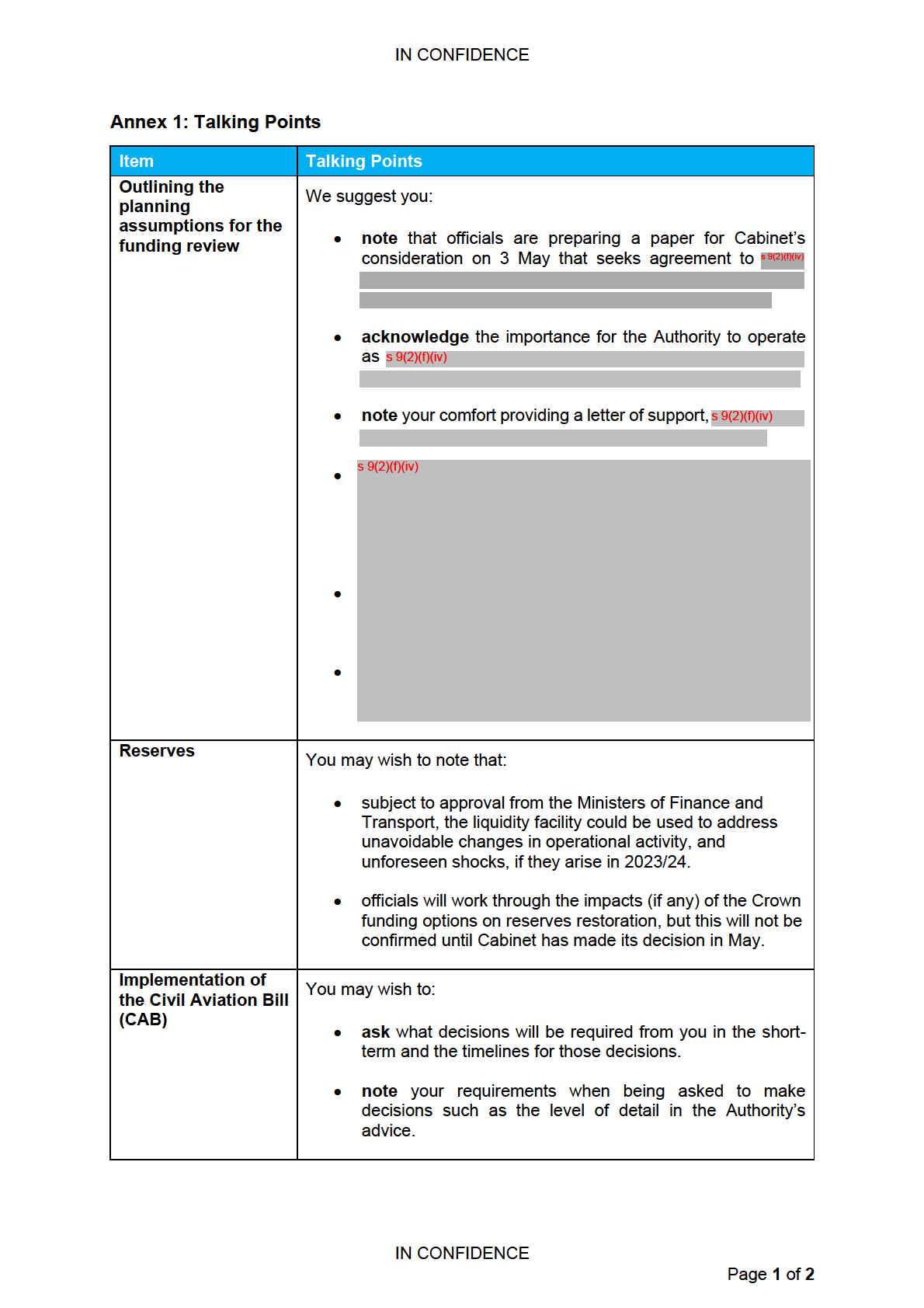
1982
ACT
UNDER
INFORMATION
RELEASED
OFFICIAL
THE
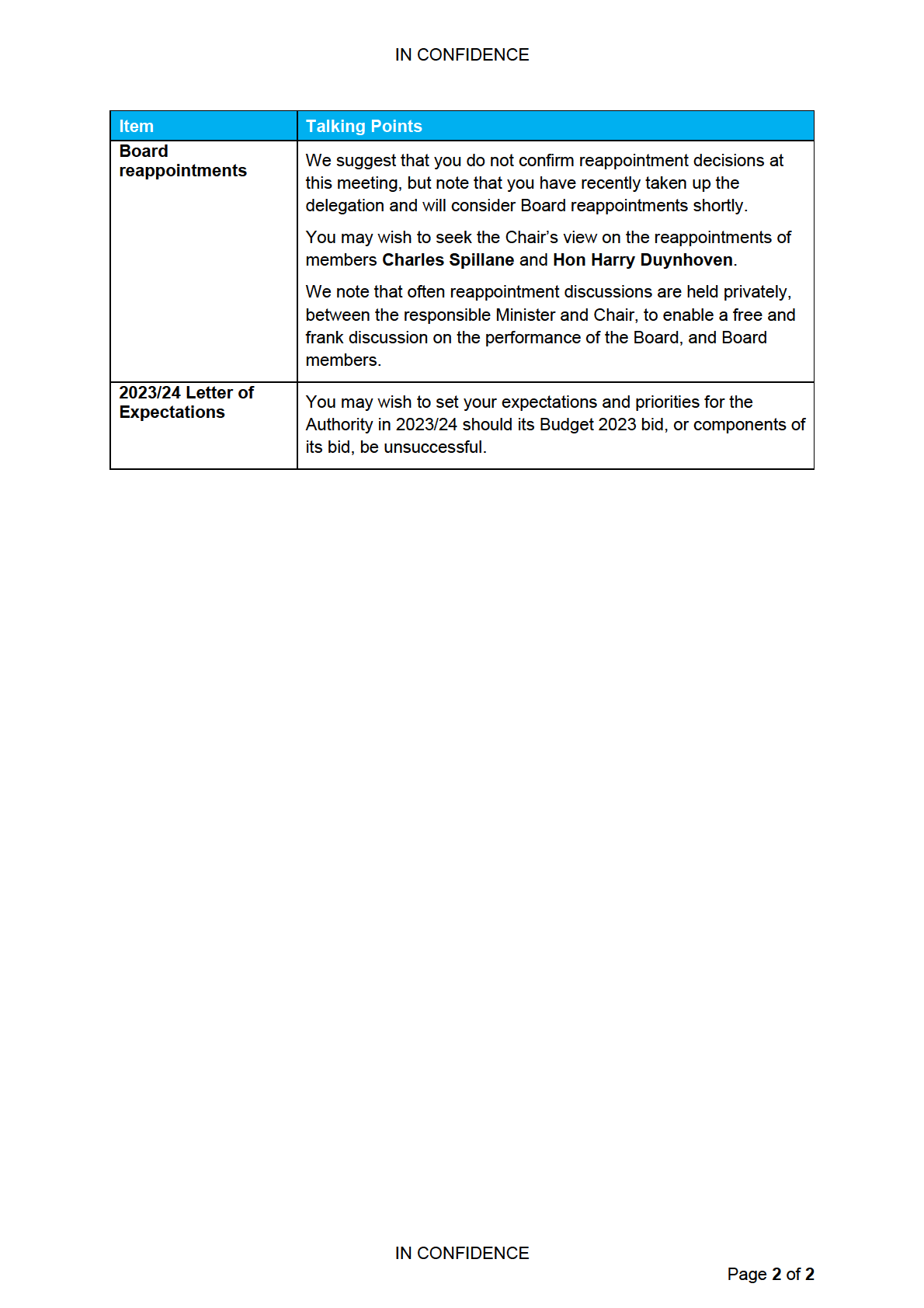
1982
ACT
UNDER
INFORMATION
RELEASED
OFFICIAL
THE






























